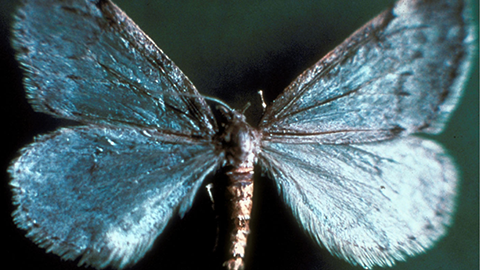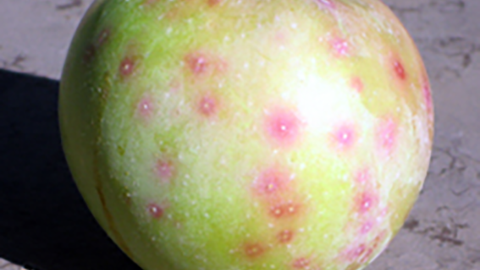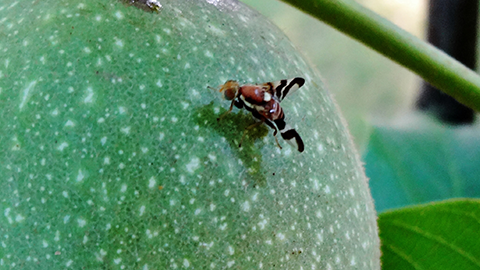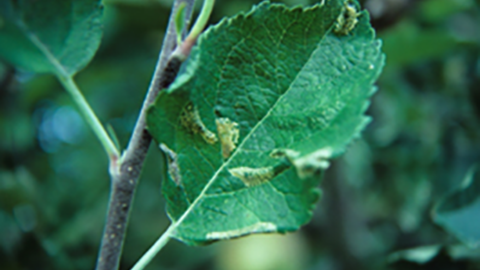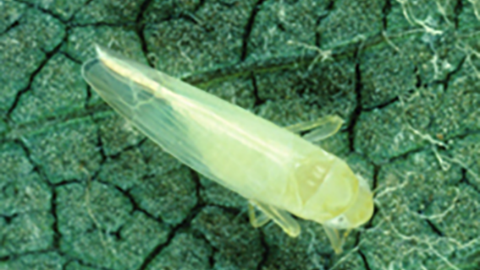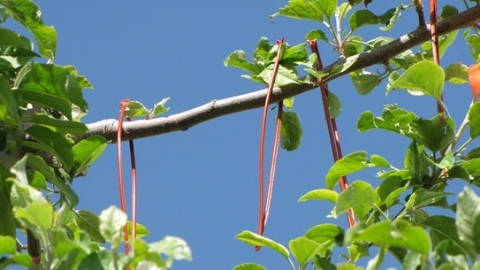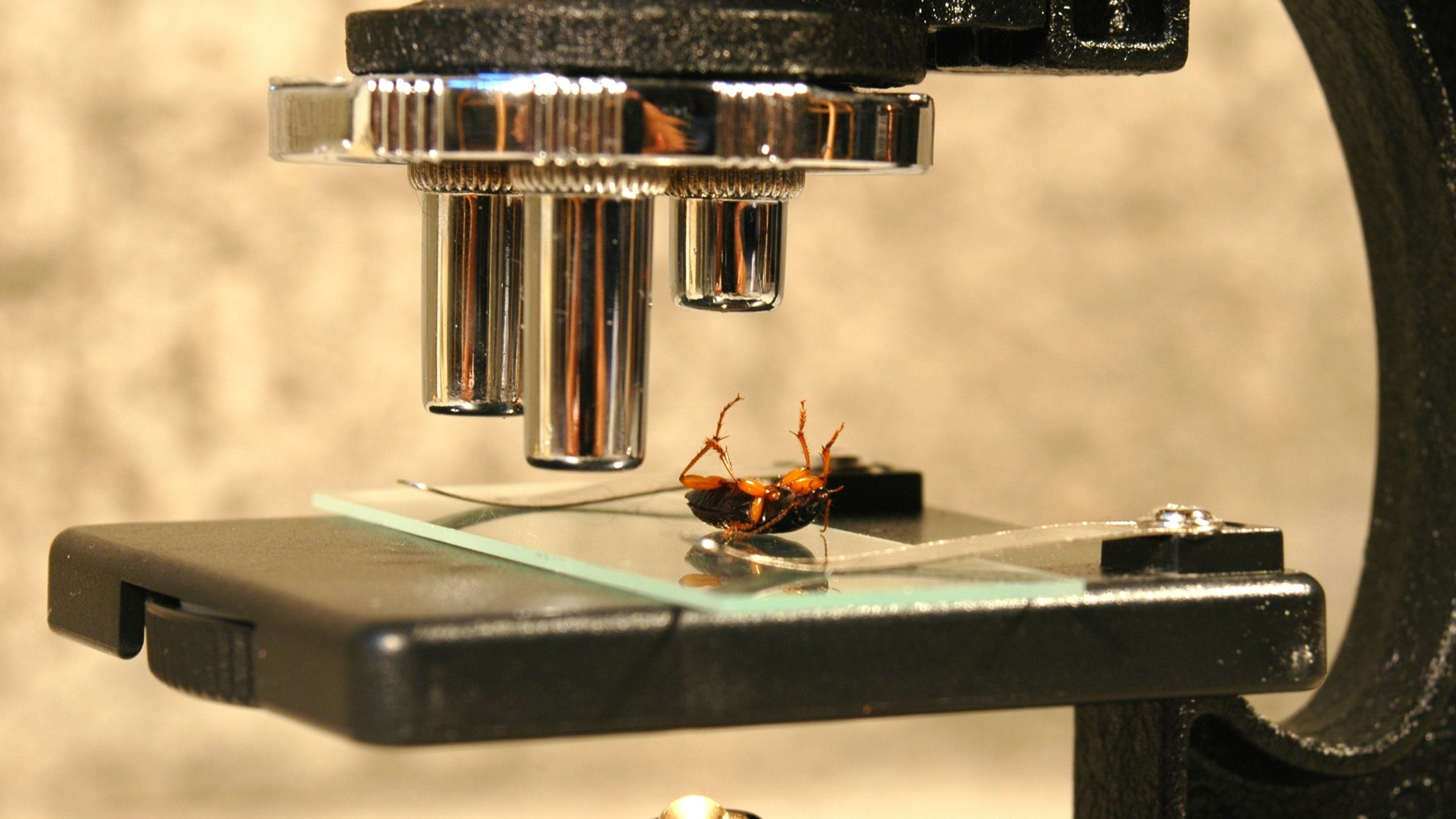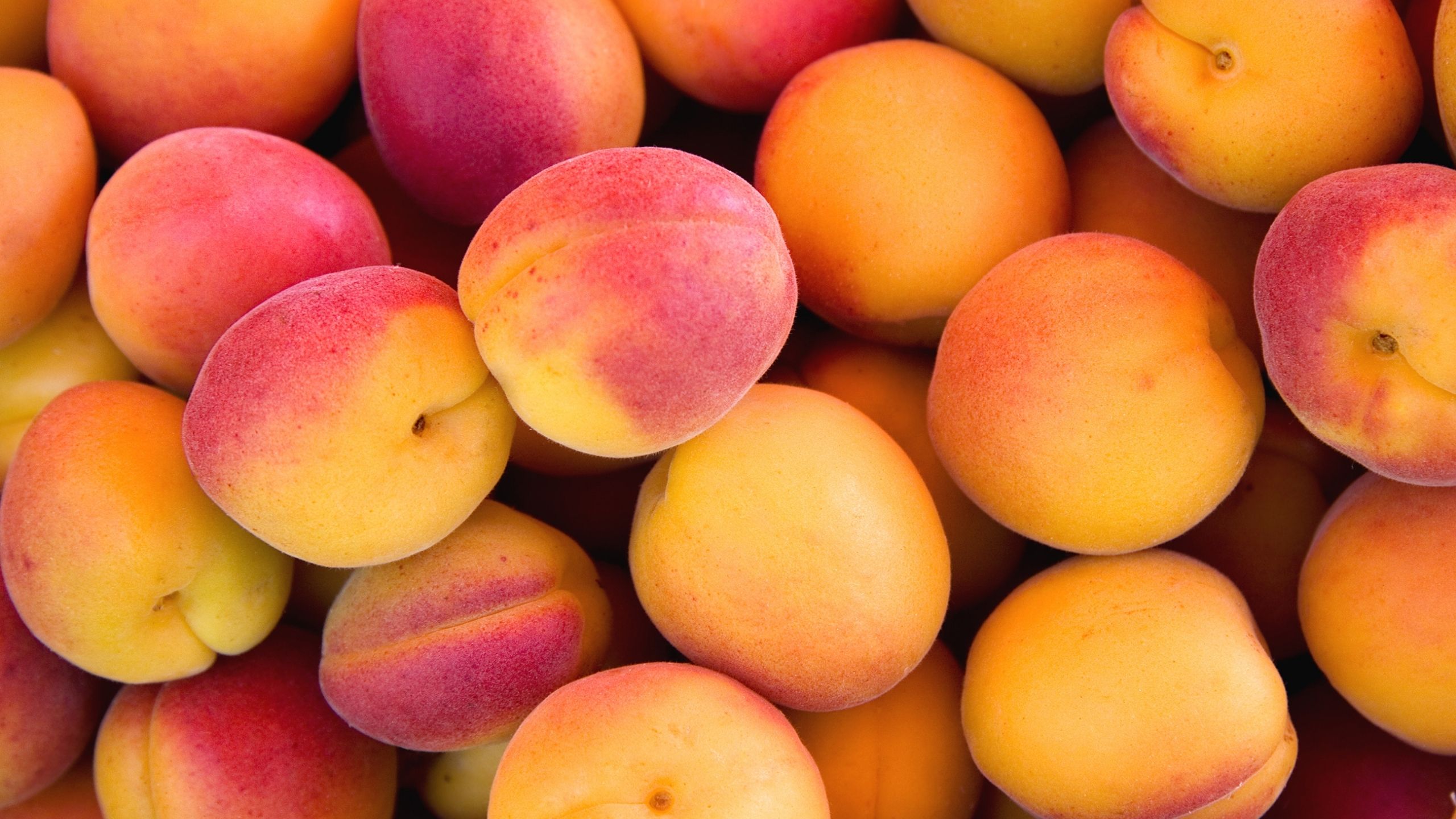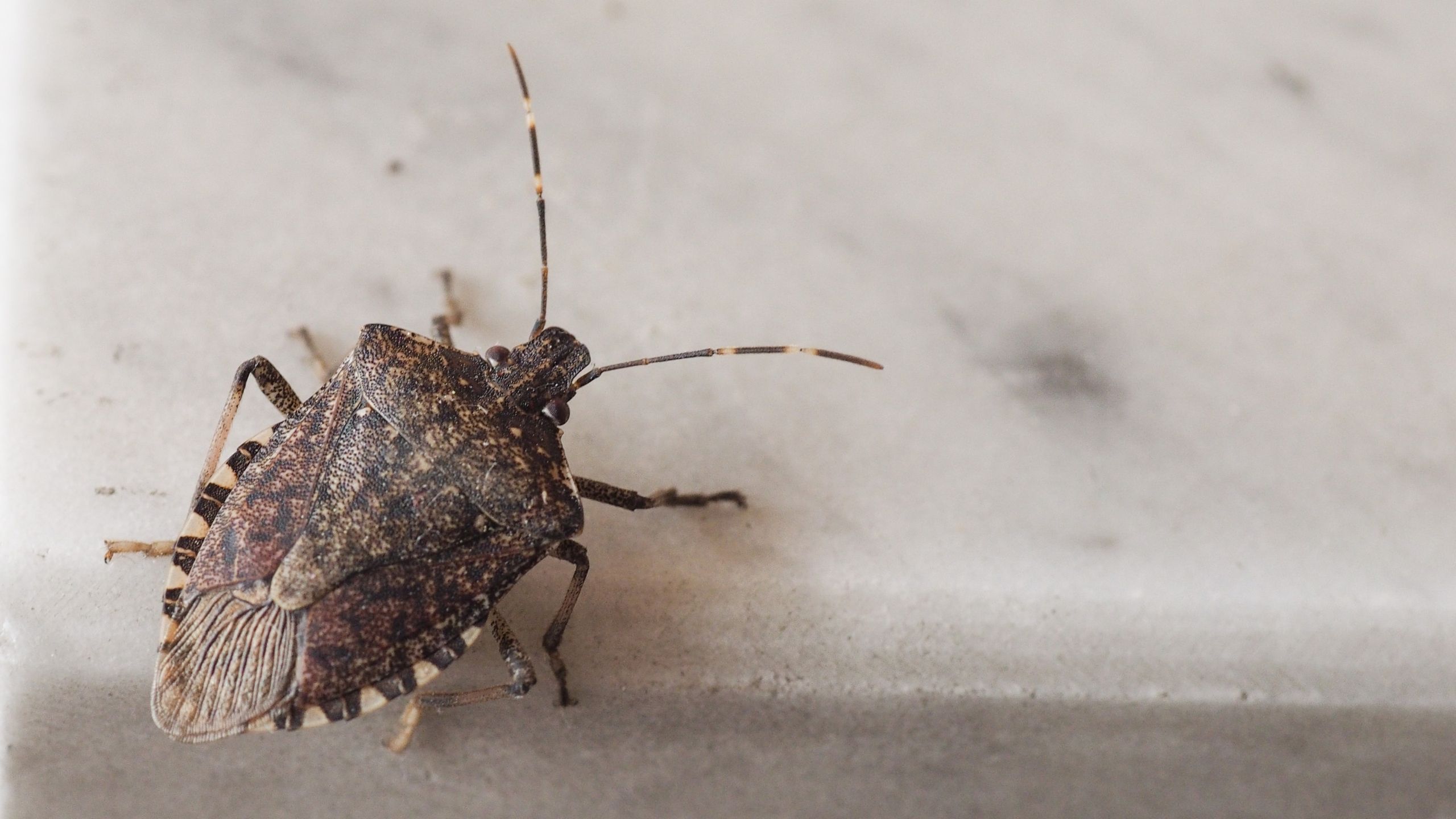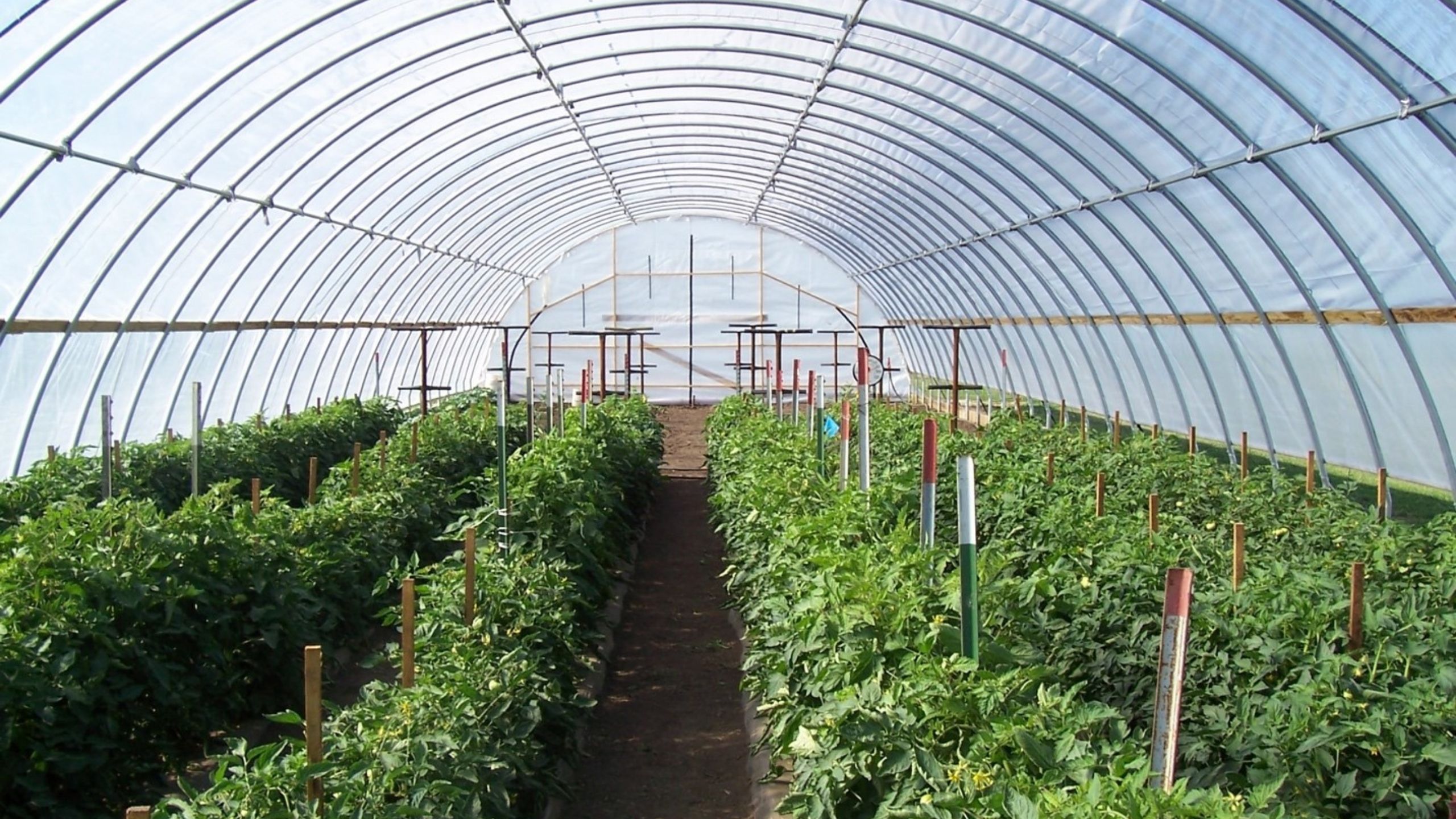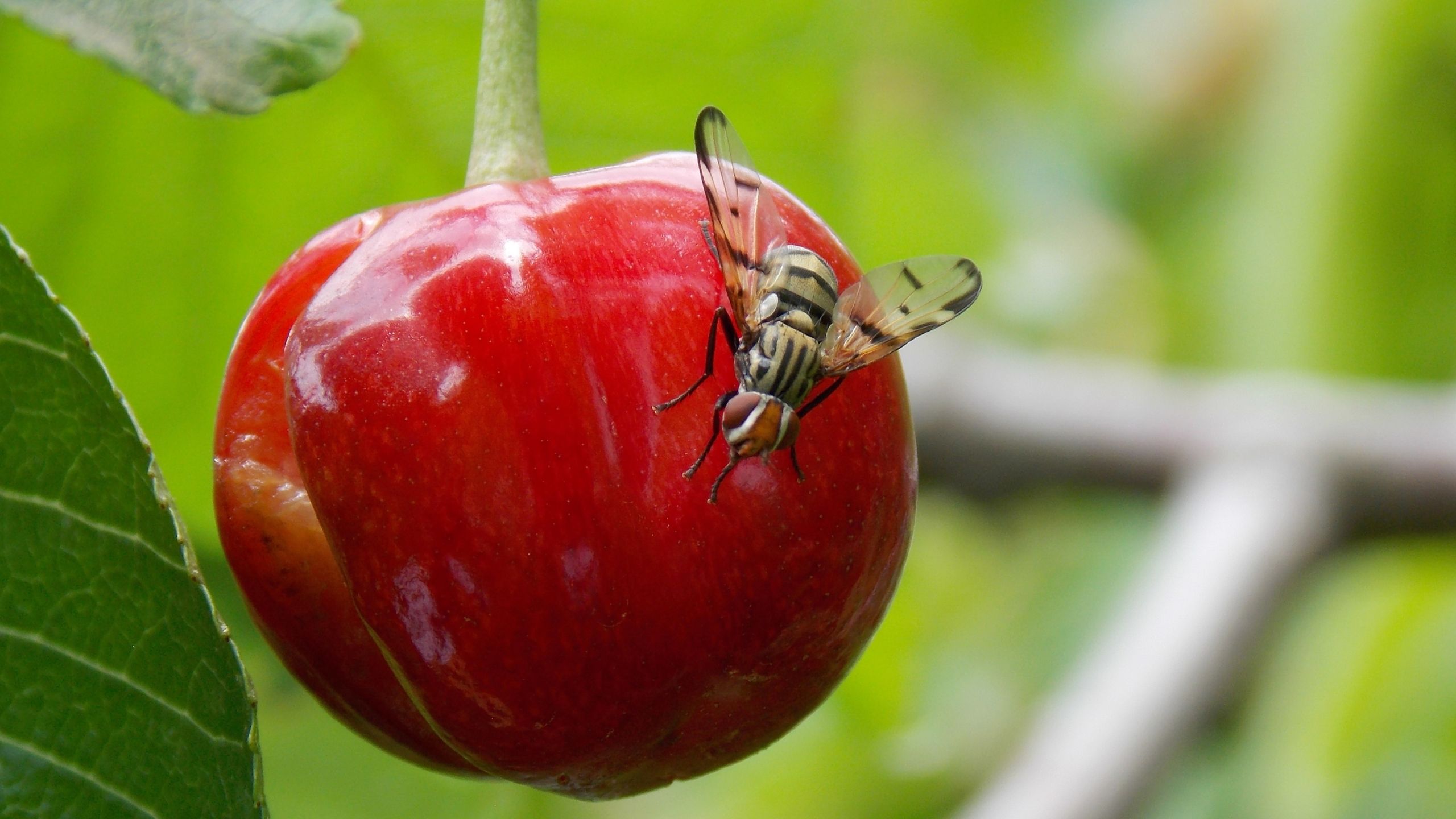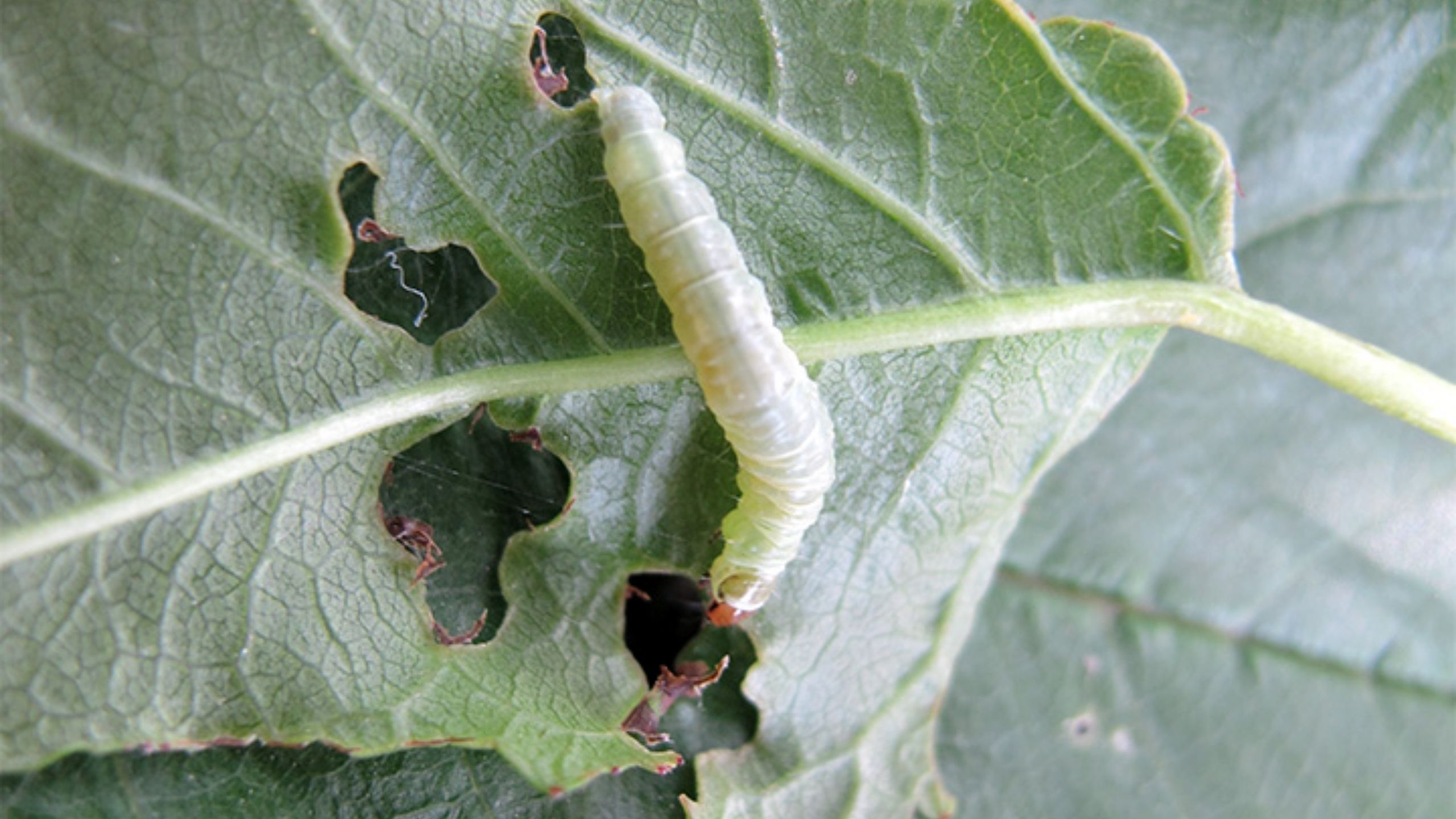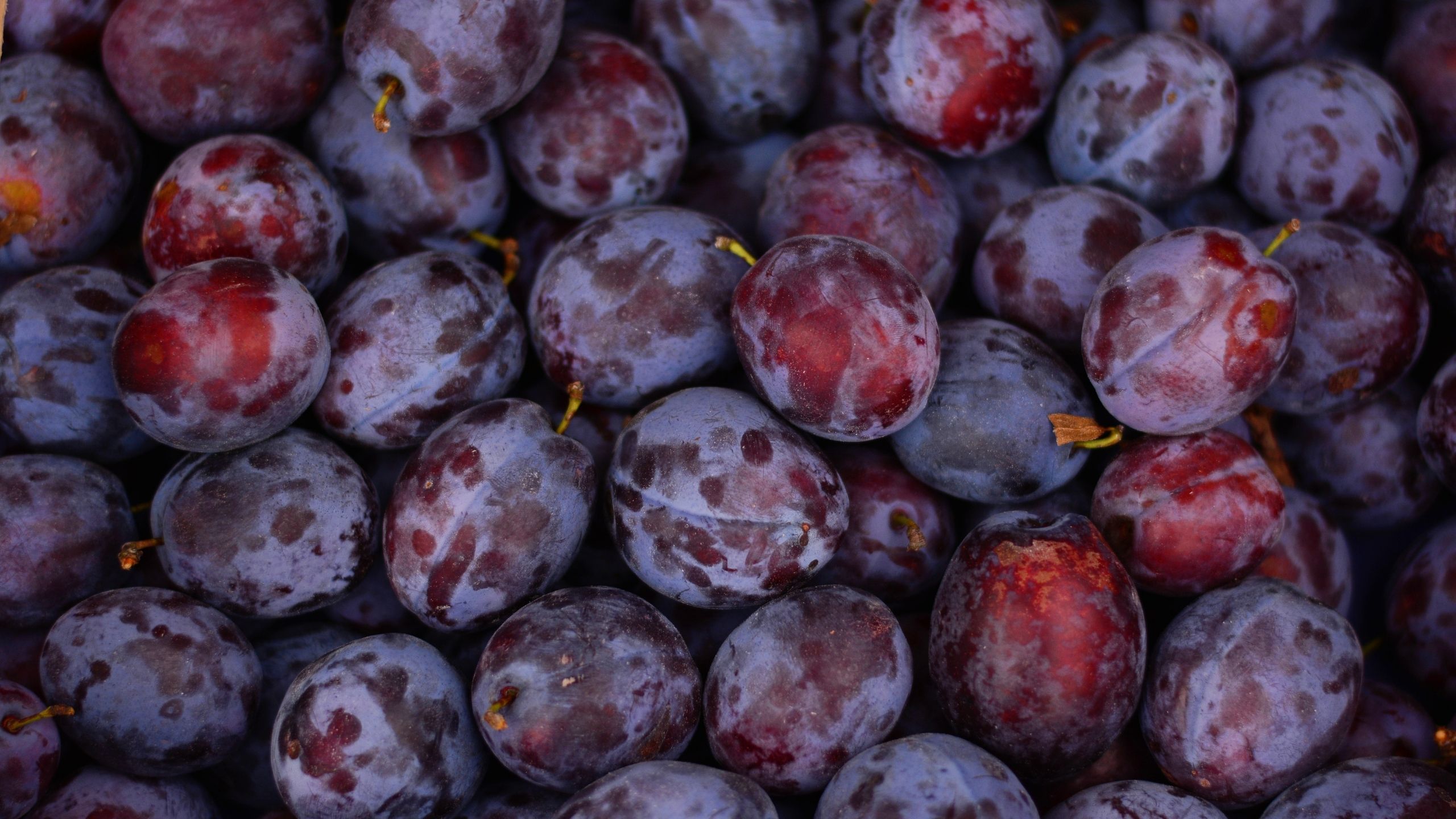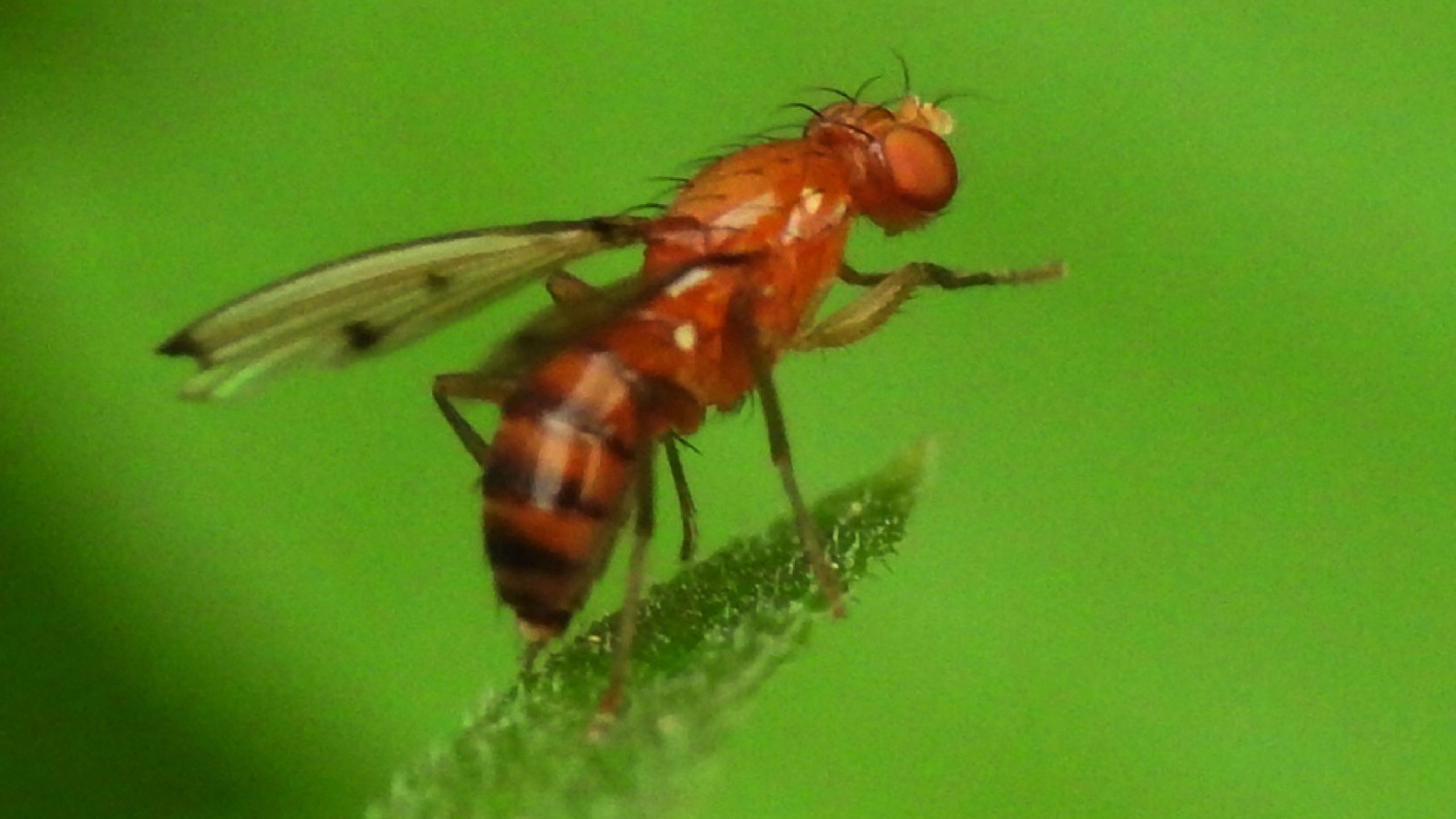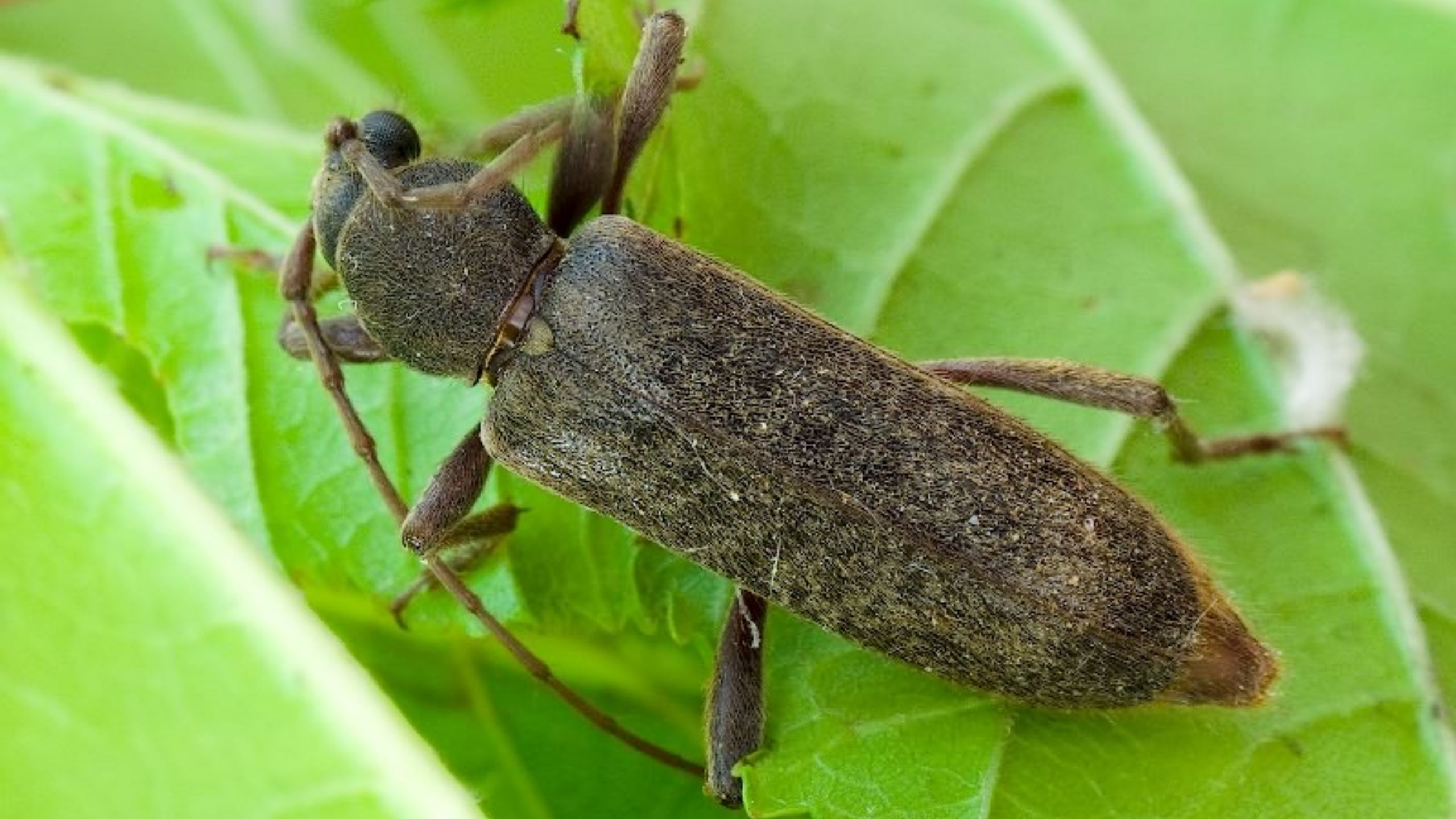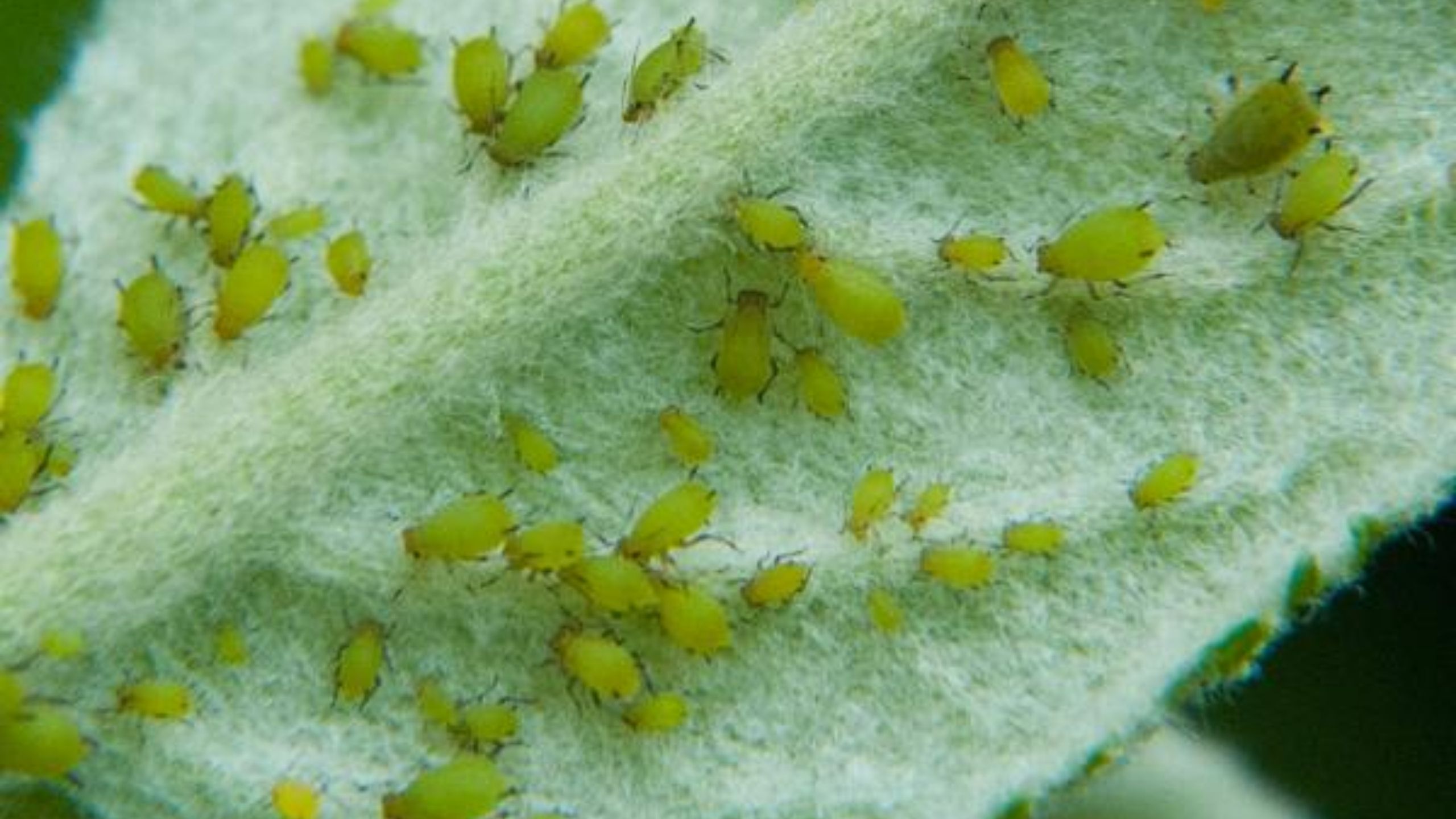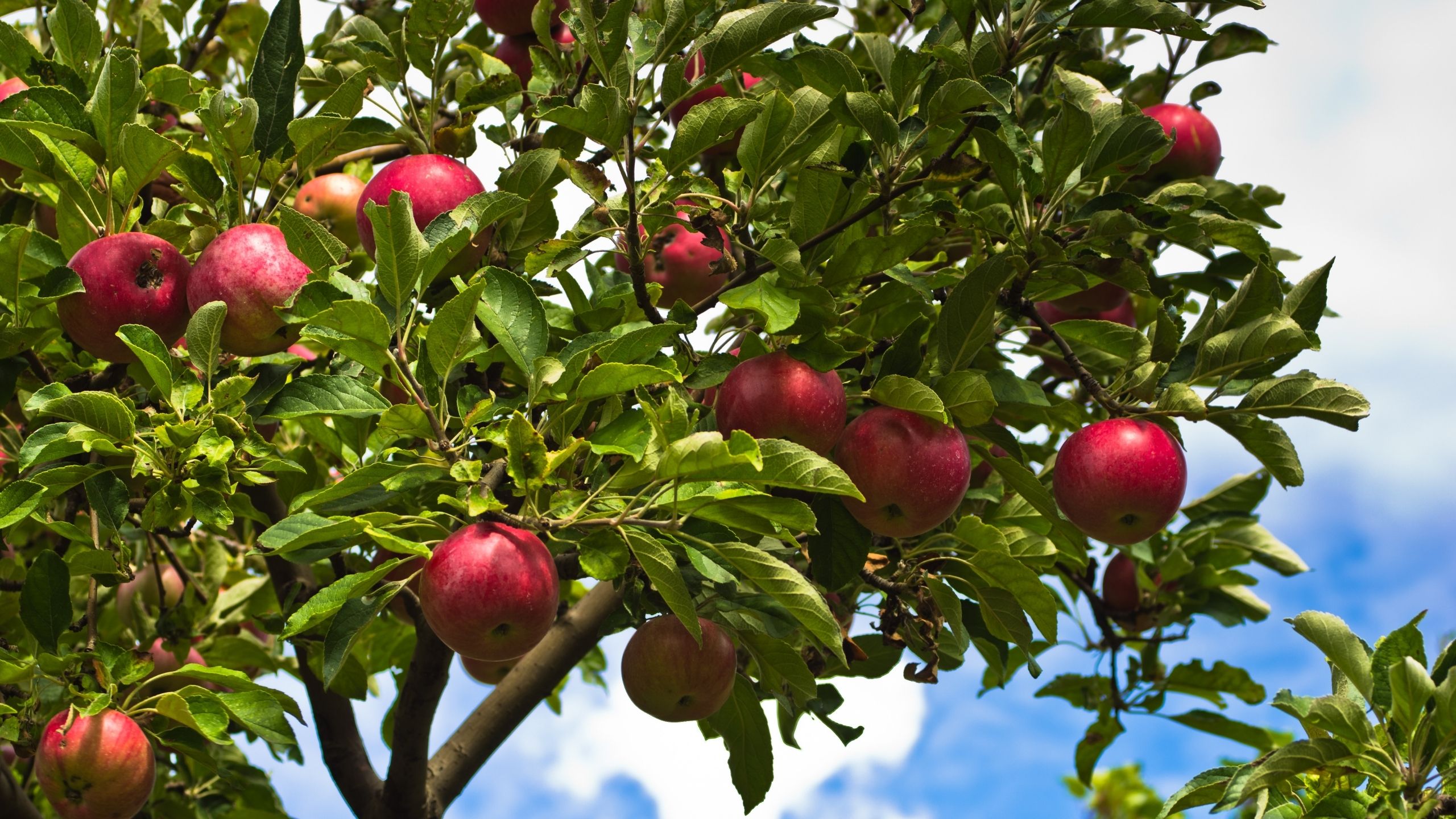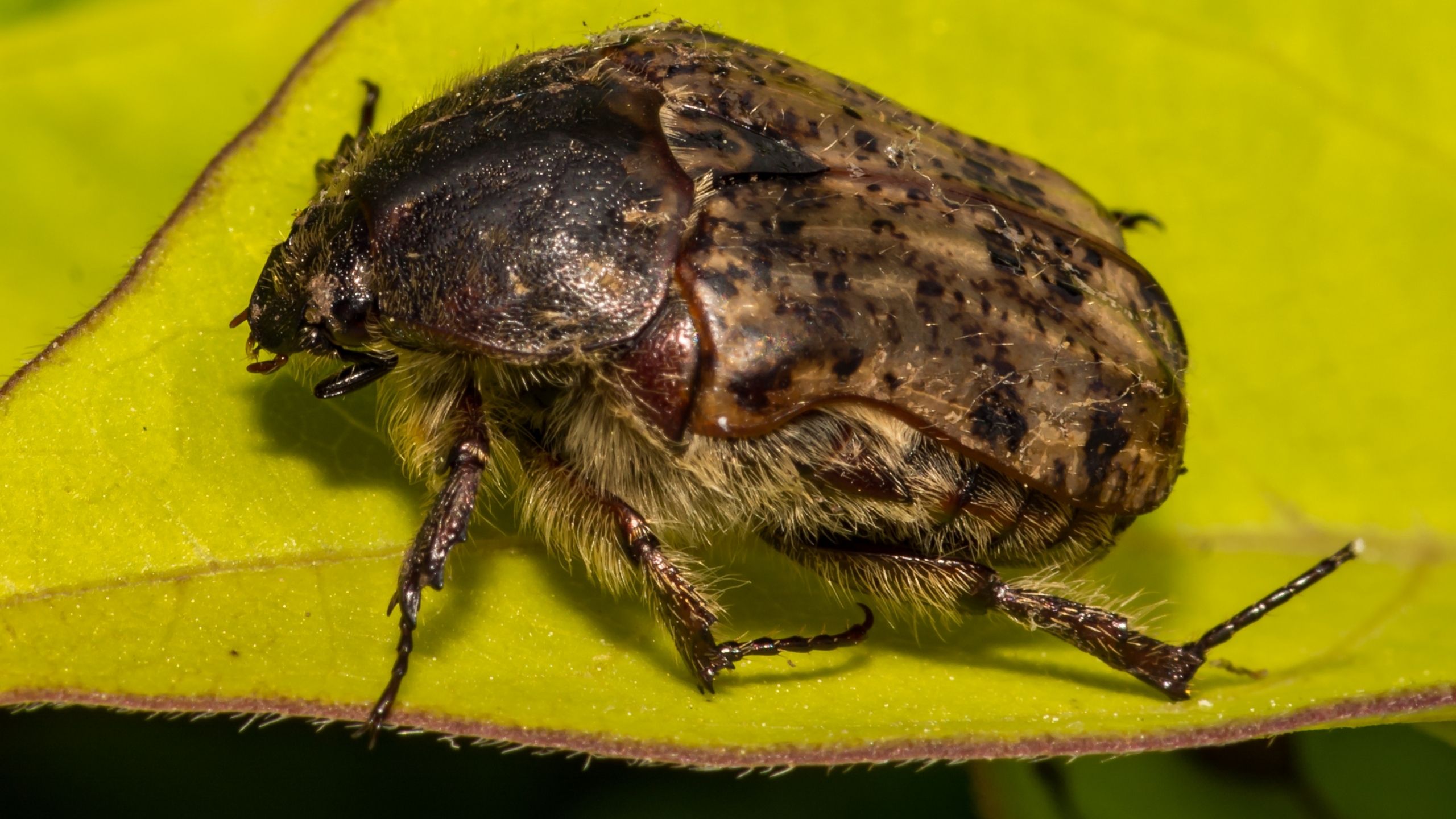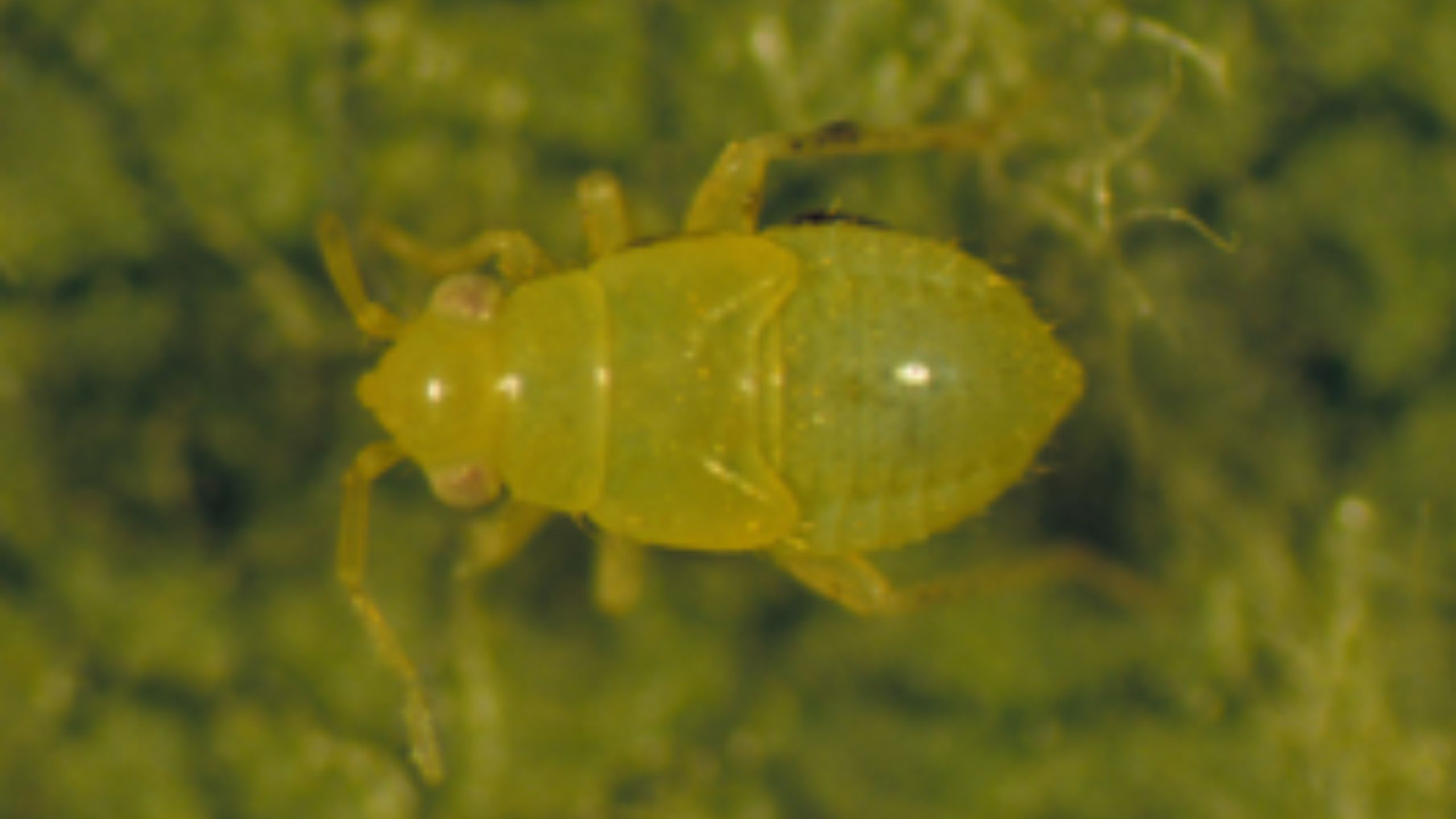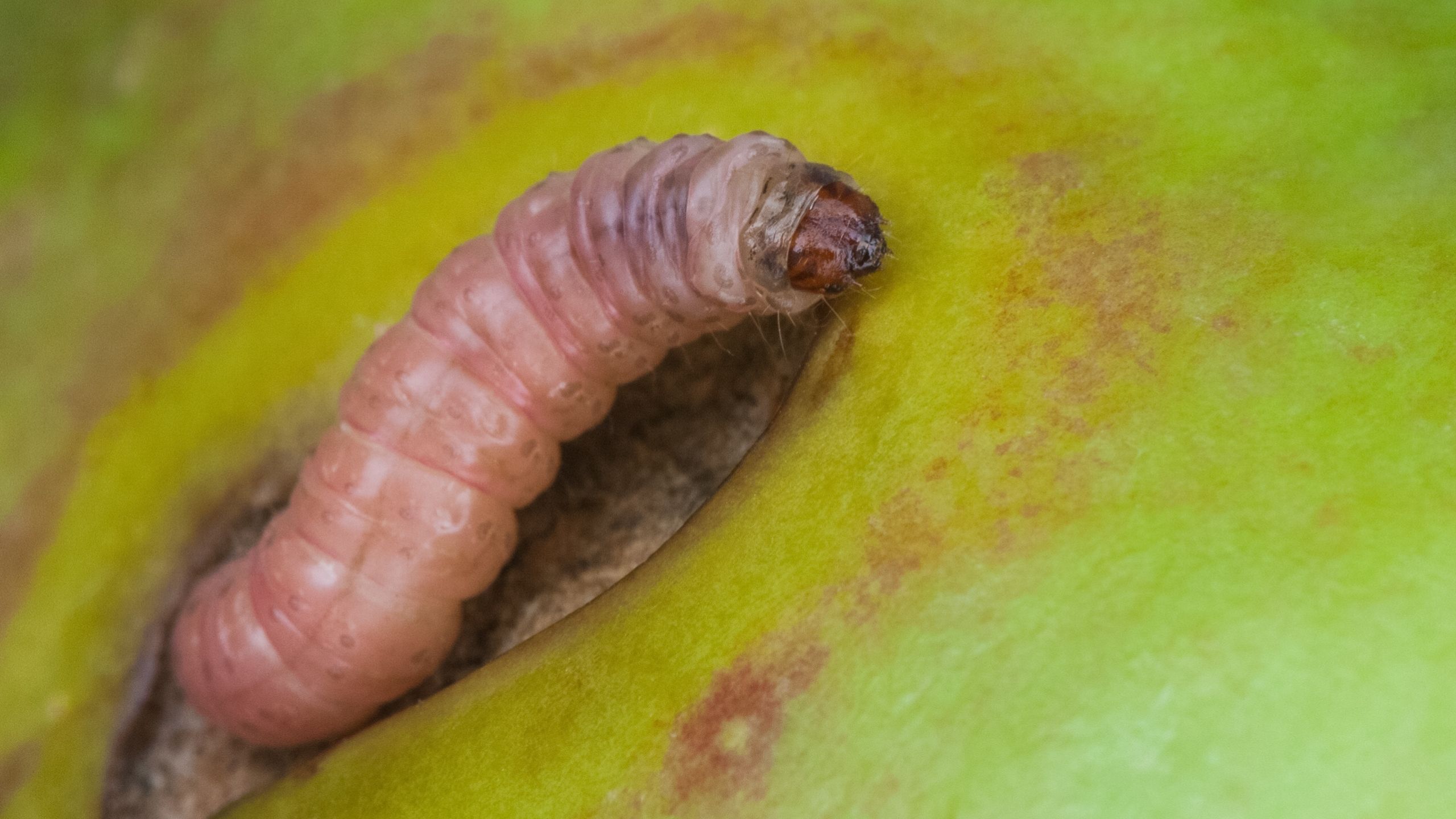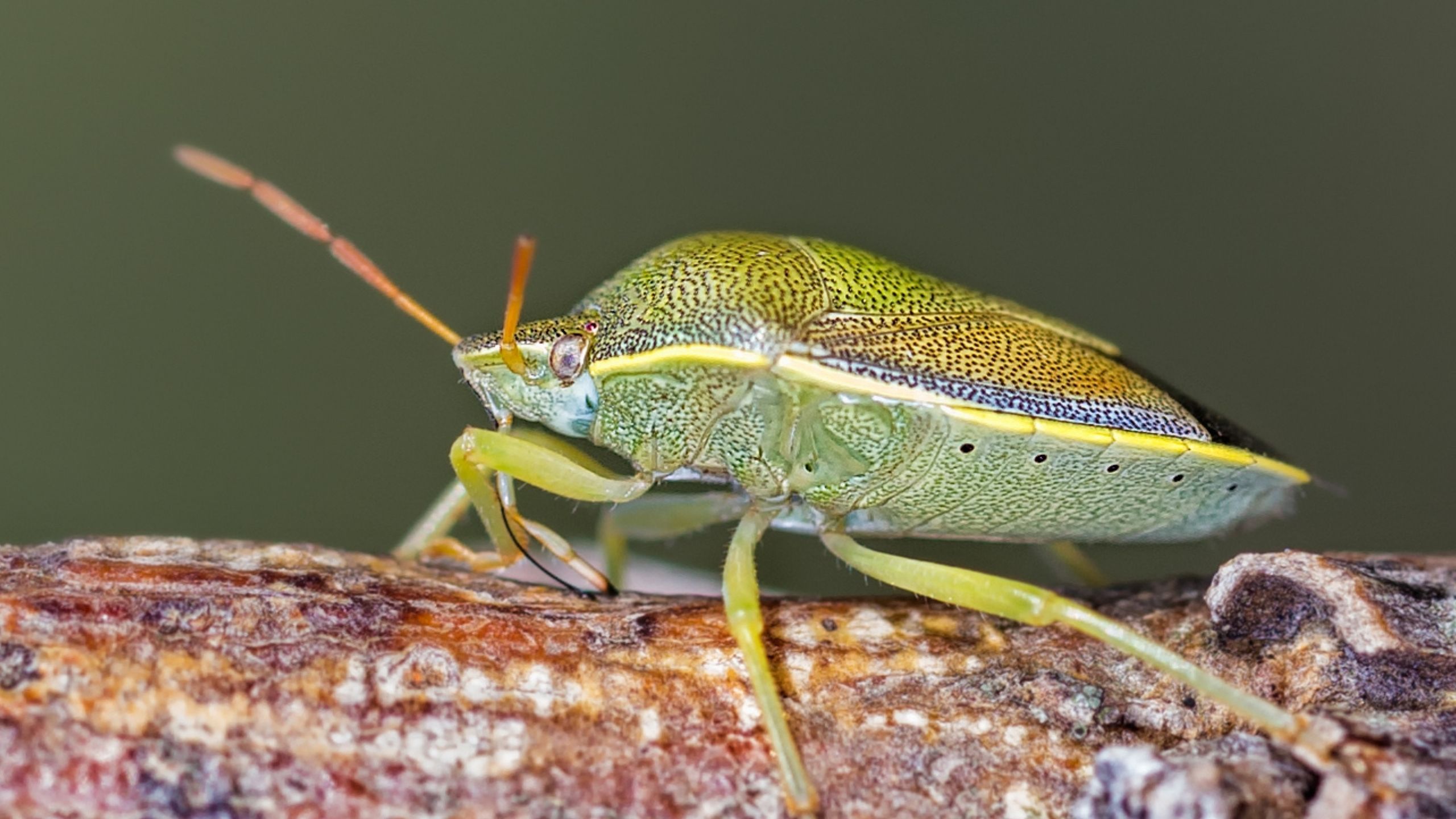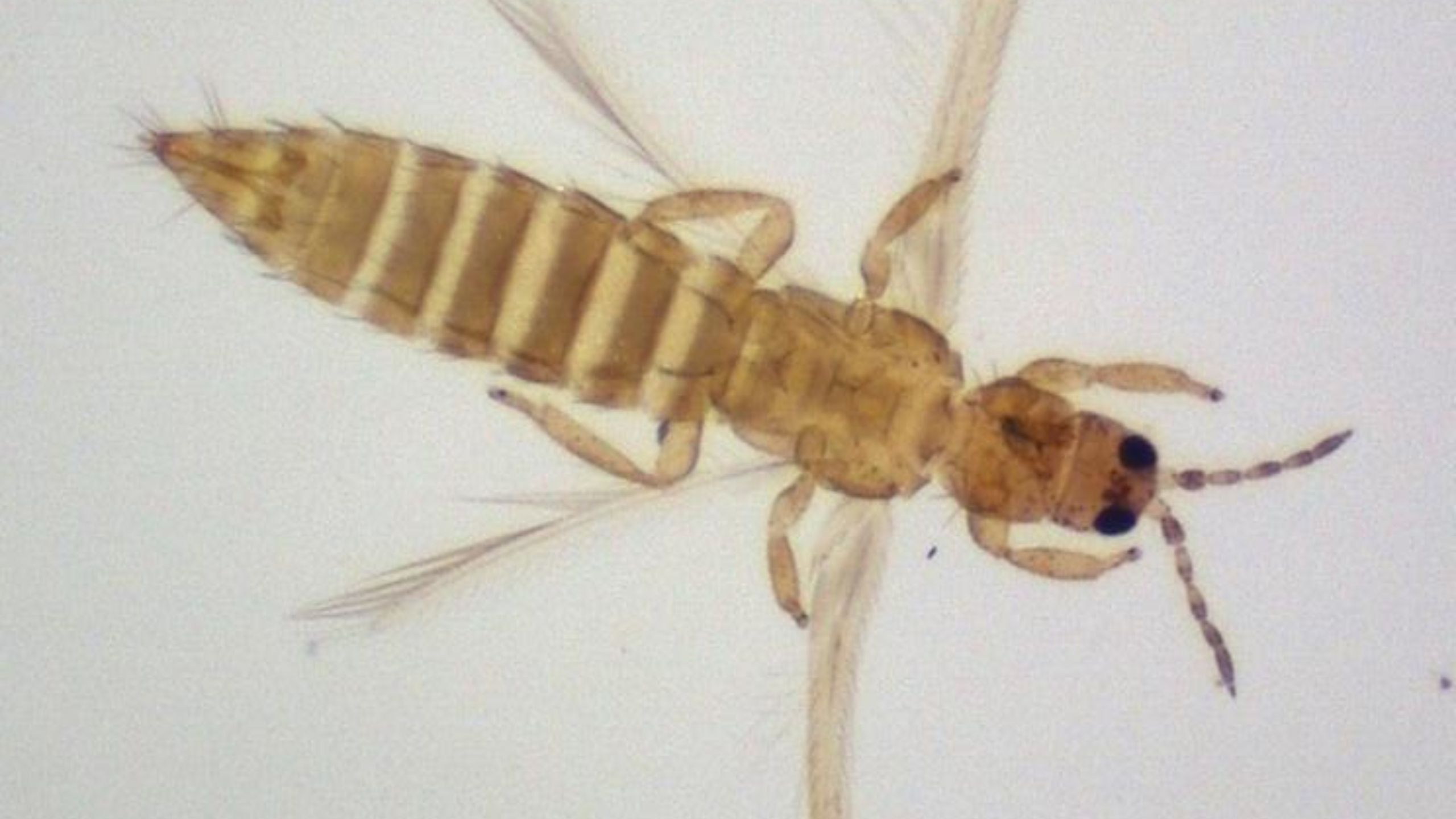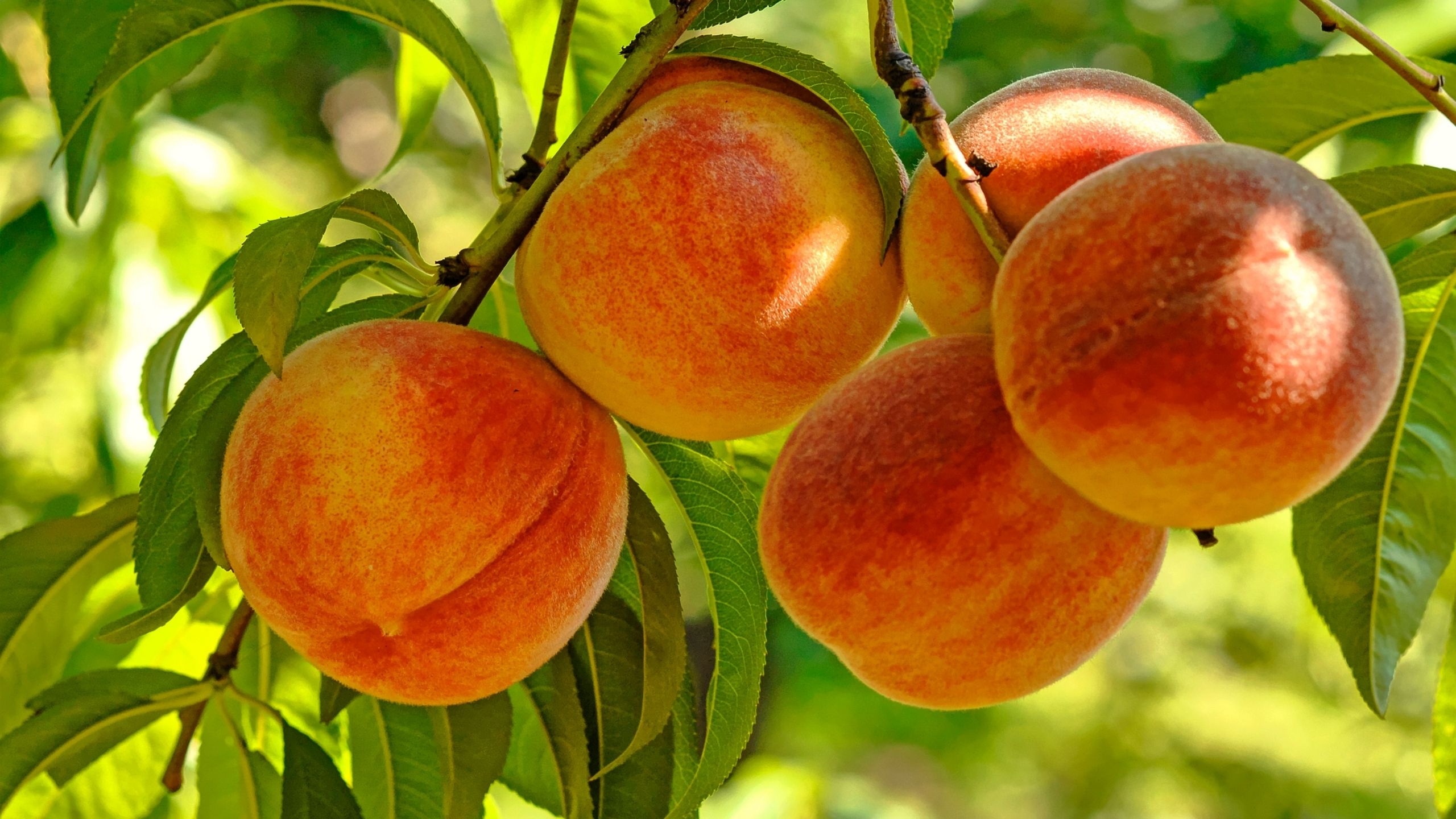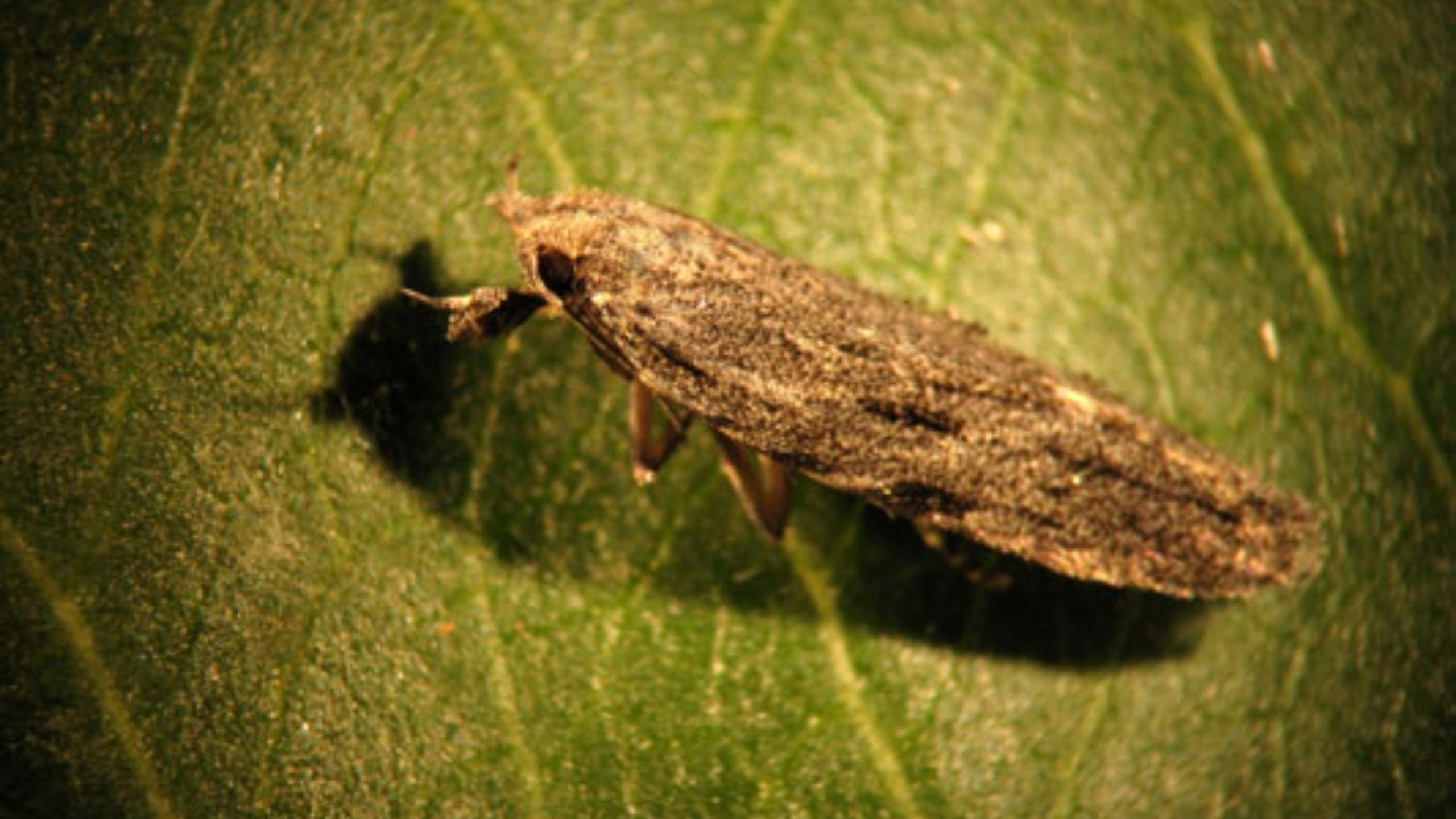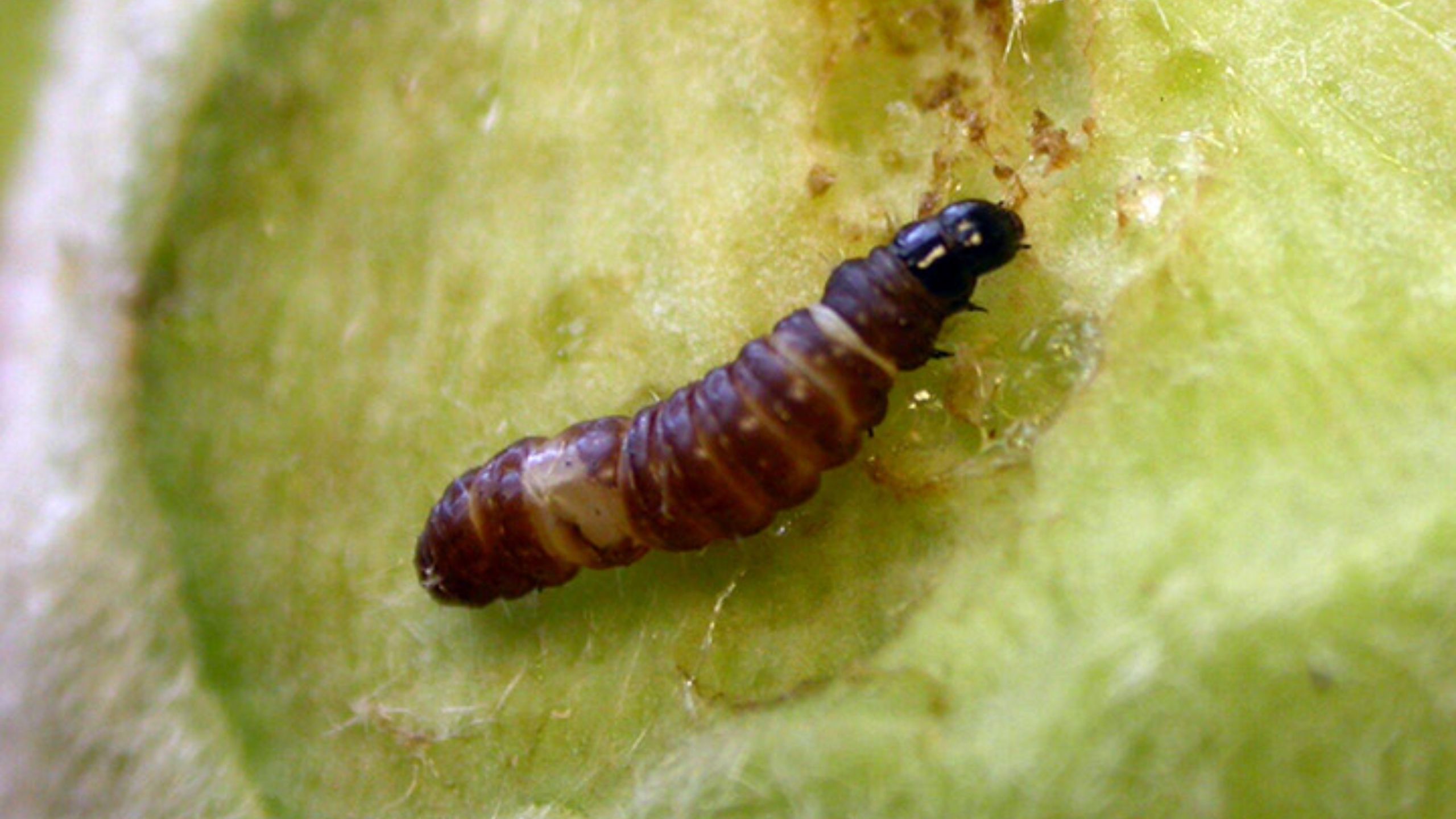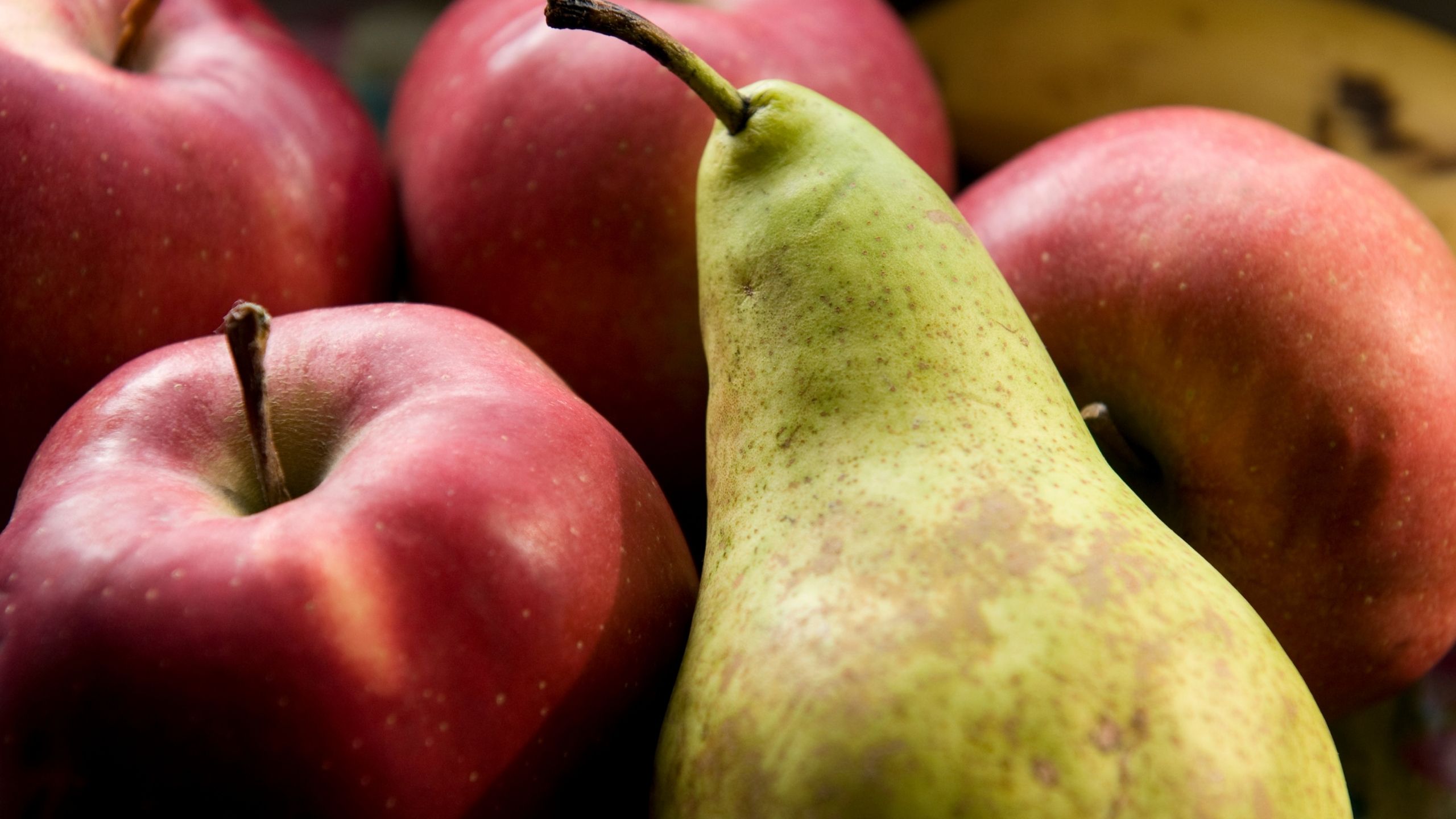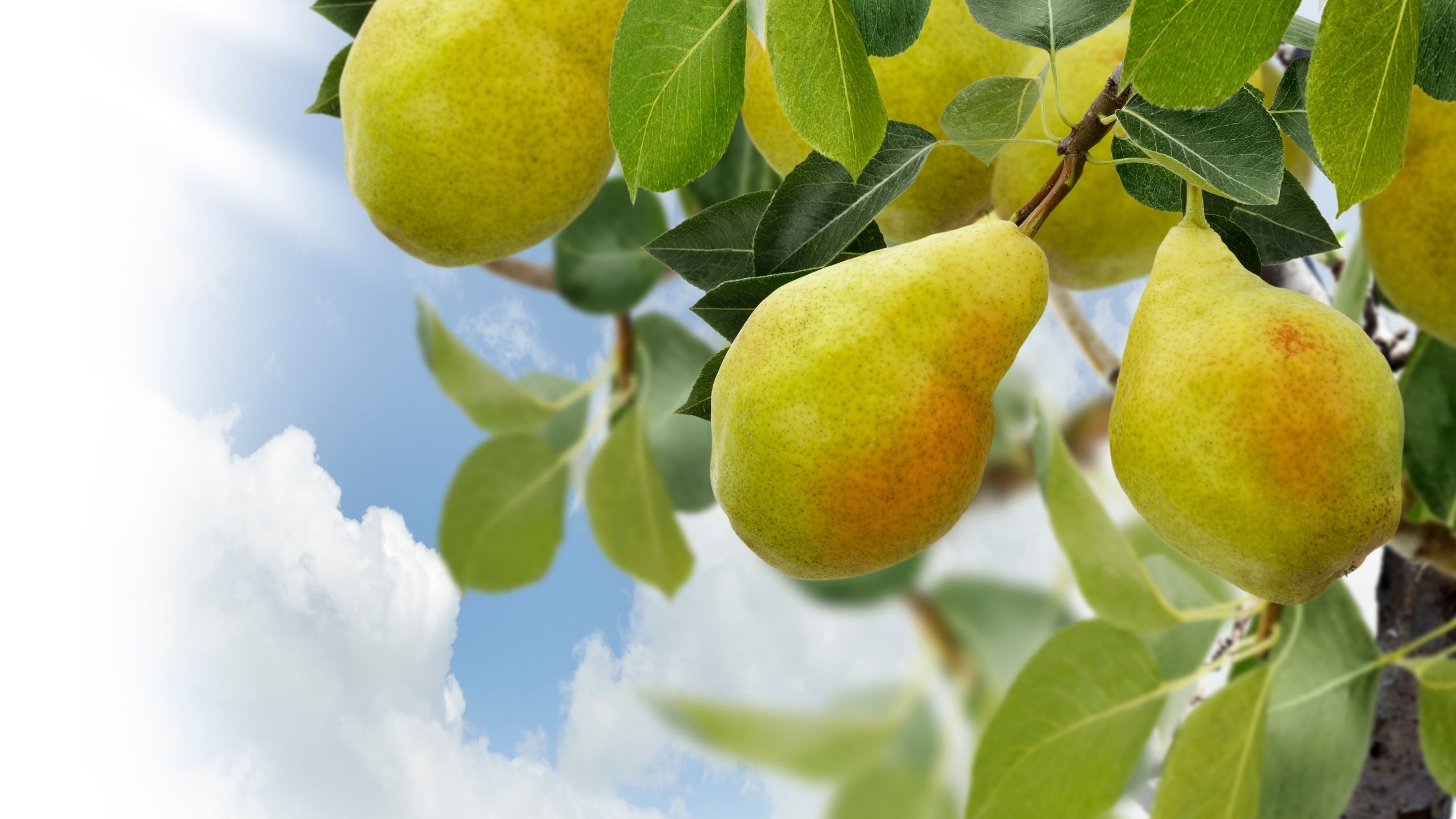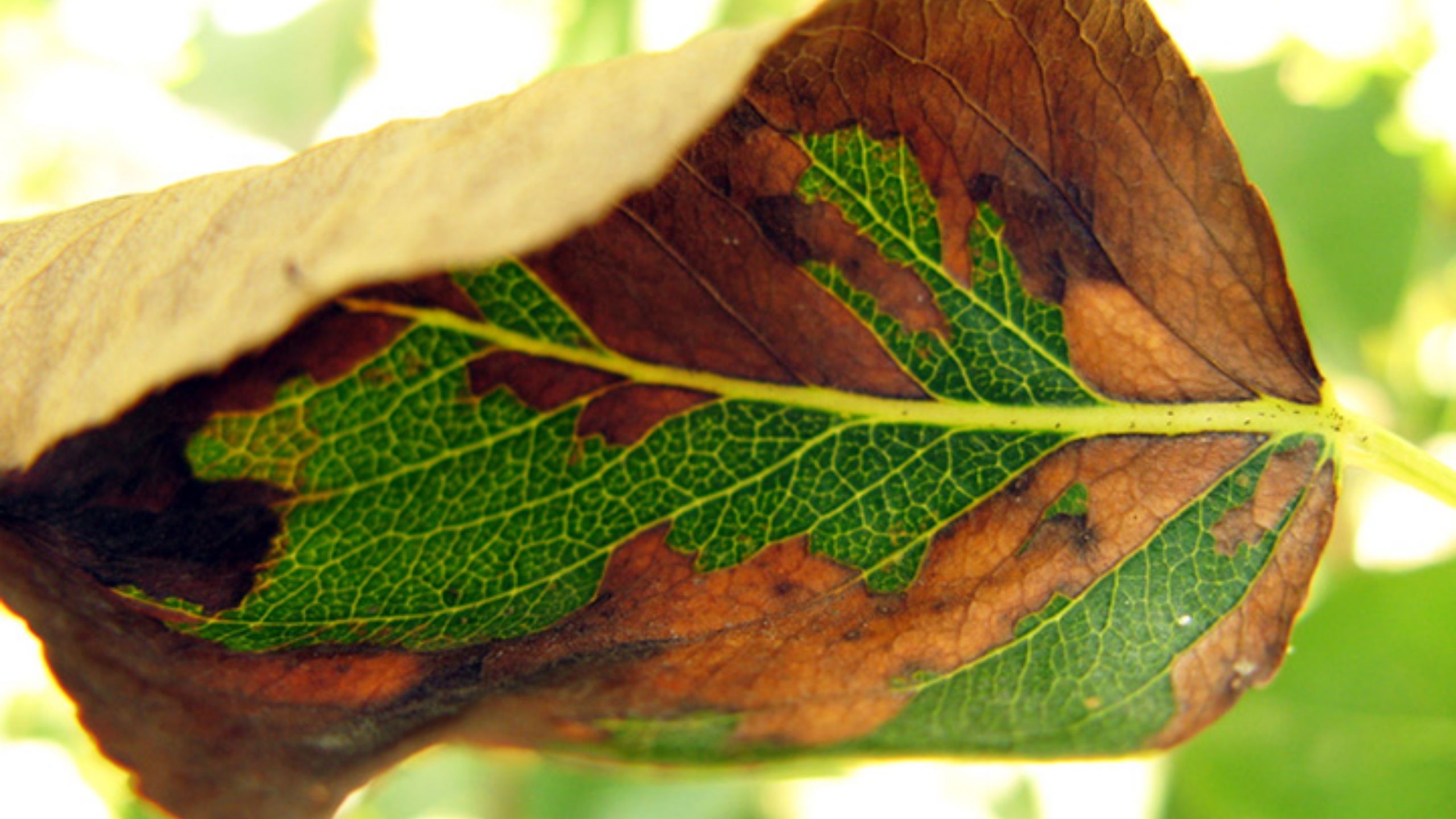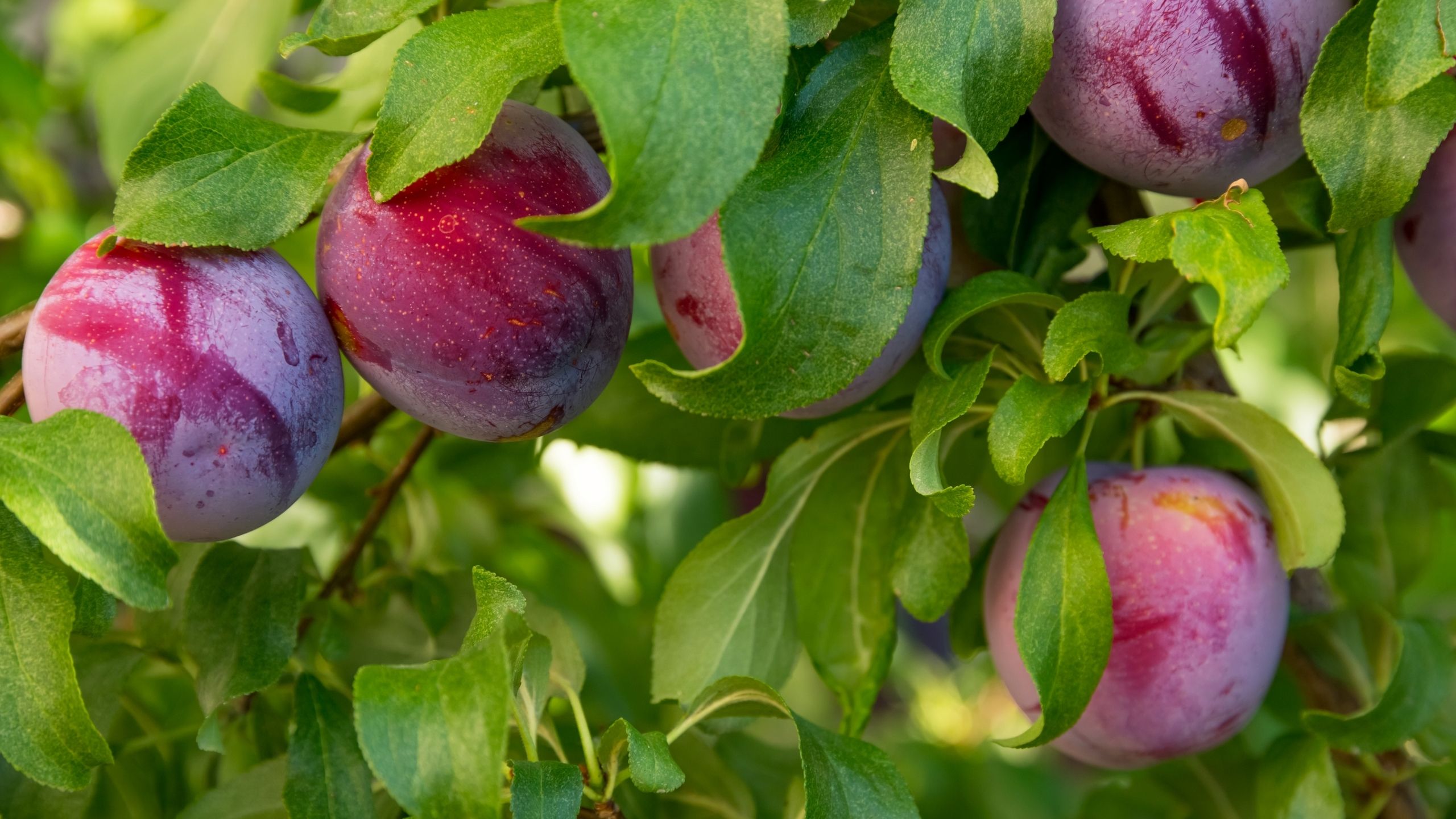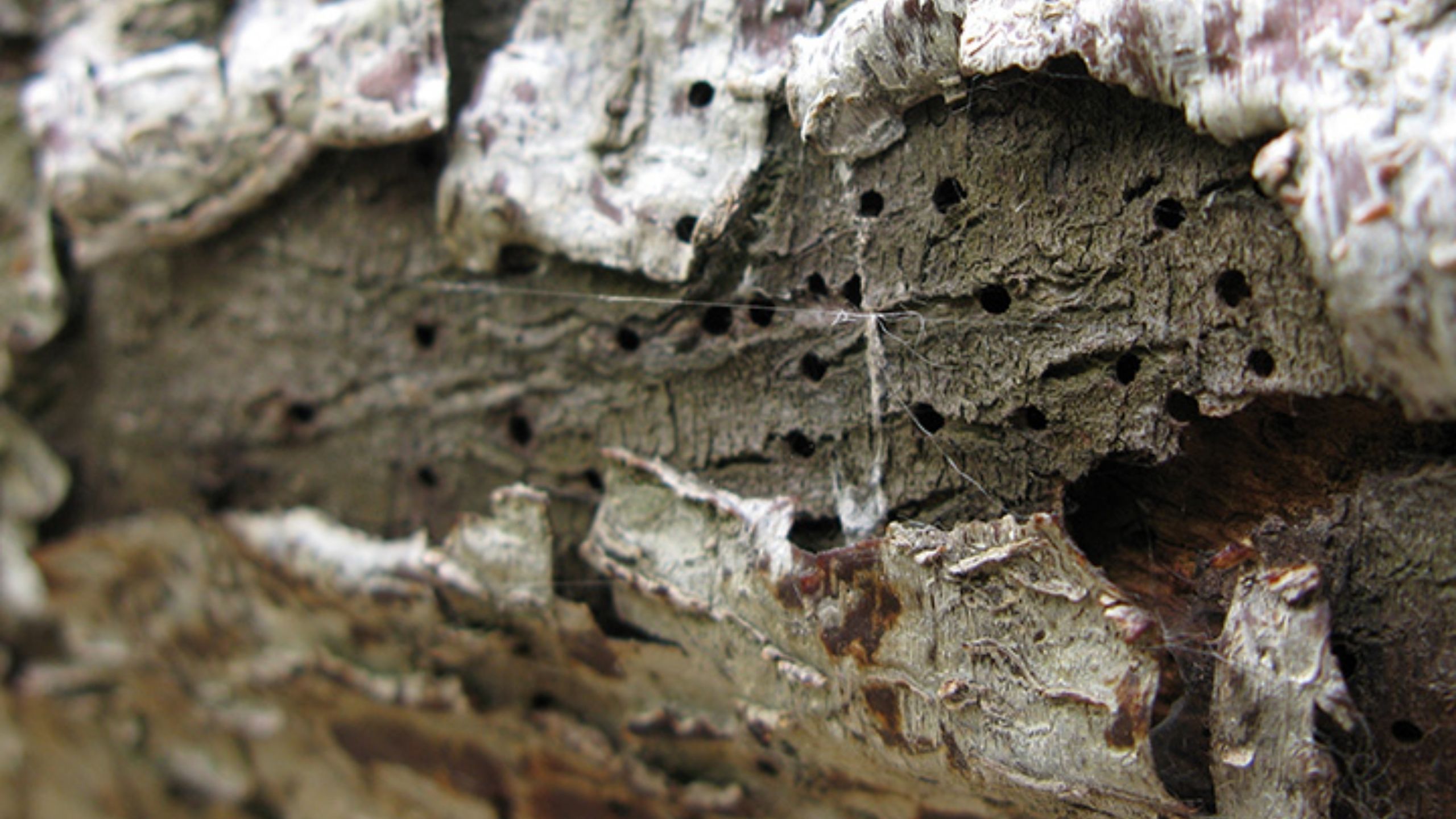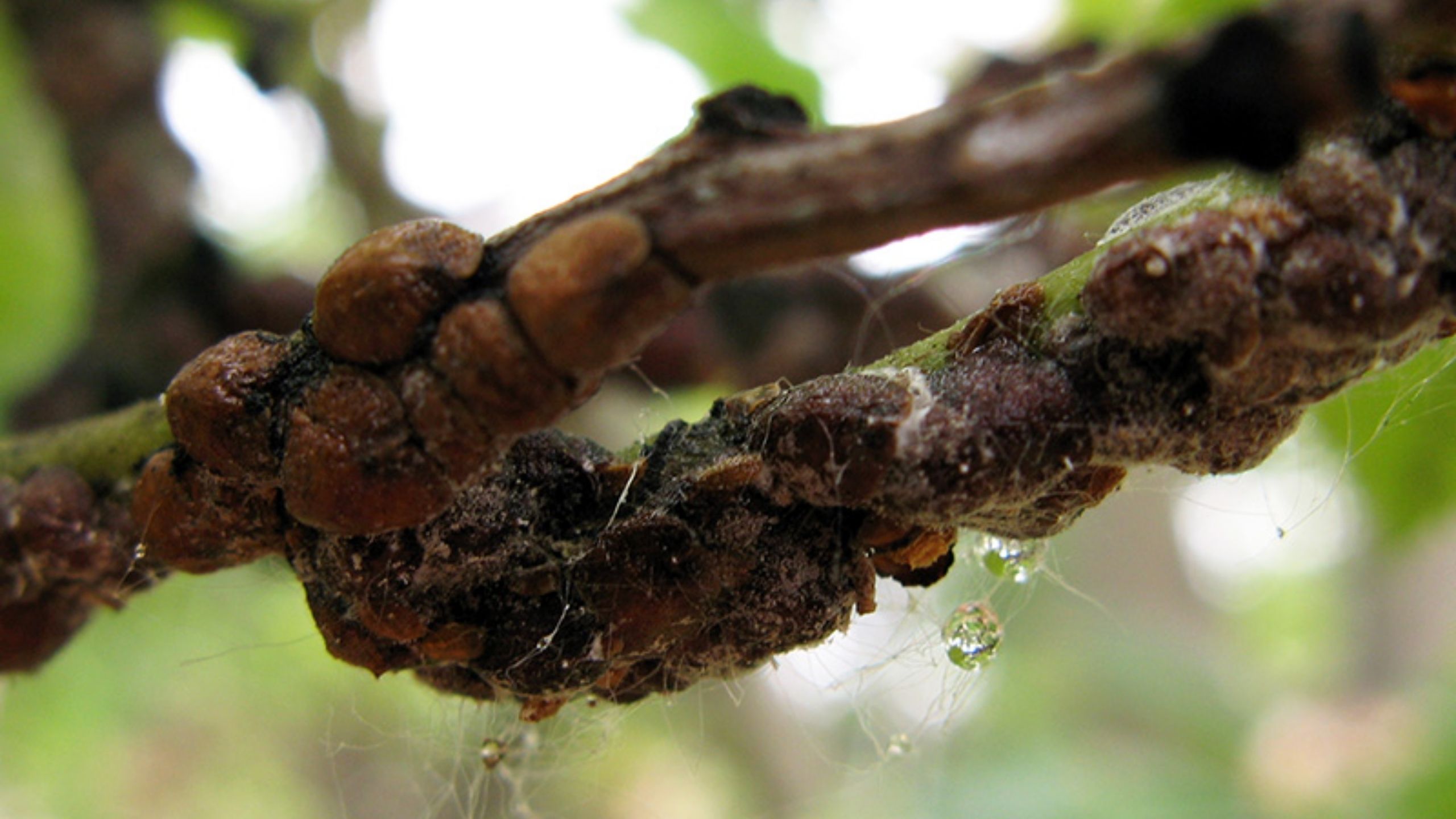Apple Maggot
January 2013
Diane Alston, Extension Entomologist (No longer at USU) • Marion Murray, IPM Project Leader
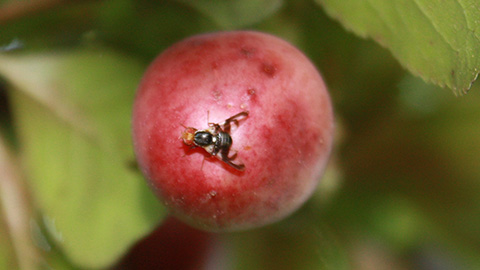
Fig. 1. Apple maggot adult on plum fruit. Note the F-shaped banding pattern on the wings. Image courtesy of Ann Weaver.
Quick Facts
- The fruit fly, apple maggot, primarily infests native hawthorn in Utah, but recently has been found in home garden plums.
- Apple maggot is a quarantine pest; its presence can restrict export markets for commercial fruit.
- Damage occurs from egg-laying punctures and the larva (maggot) developing inside the fruit.
- The larva drops to the ground to spend the winter as a pupa in the soil.
- Insecticides are currently the most effective control method.
- Sanitation, ground barriers under trees (fabric, mulch), and predation by chickens and other fowl can reduce infestations.
Apple maggot (Order Diptera, Family Tephritidae; Fig. 1) is not currently a pest of commercial orchards in Utah, but it is regulated as a quarantine insect in the state. If it becomes established in commercial fruit production areas, its presence can inflict substantial economic harm through loss of export markets. Infestations cause fruit damage, may increase insecticide use, and can result in subsequent disruption of integrated pest management programs.
This fruit fly is primarily a pest of apples in northeastern and north central North America, where it historically fed on fruit of wild hawthorn. It was first detected in the western U.S. in Oregon in 1979, and has since been found in numerous locations in the Northwest.

Fig. 2. Apple maggot larva in a plum fruit. Note the tapered head and dark mouth hooks.
It was first detected in Utah infesting cherry orchards in Mapleton (Utah County) in 1983. An extensive survey conducted in Utah in 1985 found that it was widely distributed in northern and west central areas of the state where it was most likely feeding on fruits of river hawthorn (Crataegus rivularis Nutt.) and unmanaged cherry; implicating that it is native to the state.
In 2013, the Utah Plant Pest Diagnostic Laboratory diagnosed apple maggot in plum fruits (Fig. 2) from several home gardens in Salt Lake County. Cultivated fruit is more likely to be infested if native hawthorn stands are nearby which may support large fruit fly populations, and if fruit is not treated with insecticides. Adult trapping and use of a degree-day model (based on temperature) can be used to optimally time treatments for apple maggot.
HOSTS
- Apple and crabapple (Malus spp., common cultivated hosts in eastern U.S.)
- Hawthorn (Crataegus spp., native host)
- Prunus spp. (plum, cherry, apricot)
- Pear (Pyrus spp.)
- Wild rose (Rosa spp.)
- Mountain ash (Sorbus spp.)
- Cotoneaster (Cotoneaster spp.)
- Firethorn (Pyracantha spp.)
DESCRIPTION AND LIFE HISTORY

Fig. 3. Life history of apple maggot. There is one generation per year. Host fruits that mature from July to early October are most at risk for infestation if apple maggot is present.
Adult: fruit-infesting and monitoring stage (late June to early October)

Fig. 4. Wing banding patterns for apple maggot, western cherry fruit fly, and walnut husk fly.

Fig. 5, left. Close-up of head of larva. Note the tapered head with two black mouth hooks and lobed anterior spiracles (respiratory openings).
Fig. 6, right. Close-up of blunt posterior end of larva with flat paired caudal spiracles.
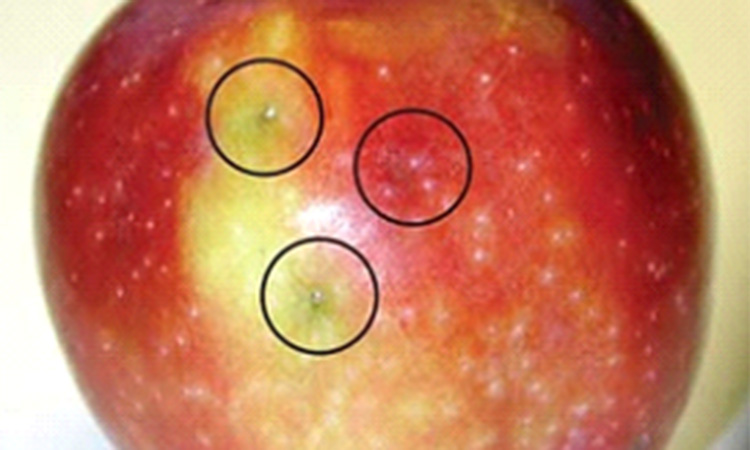
Fig. 7. Apple maggot ovipositor punctures in apple fruit. Image courtesy of the University of Minnesota.
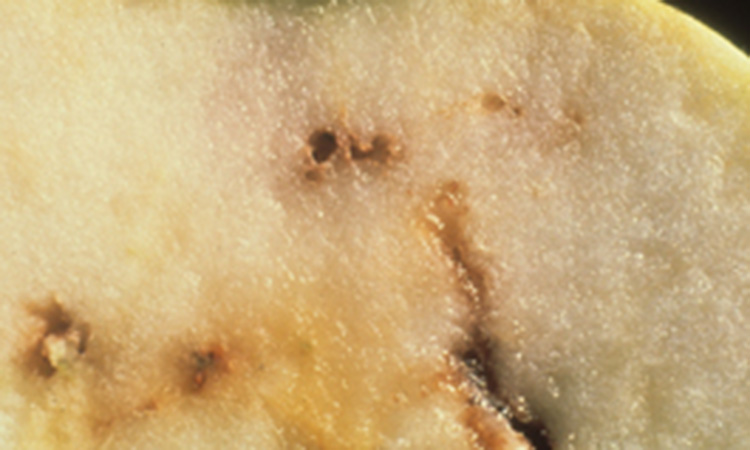
Fig. 8. Apple maggot larvae tunnels in apple flesh. Image courtesy of J. Brunner, Washington State University.

Fig. 9. Breakdown of plum flesh from apple maggot injury.
- Black-bodied fly similar in size to a house fly (1/4 inch or 6 mm long)
- Eyes are dark red; a prominent white spot on its lower thorax (back)
- Dark bands on the clear wings form a distinctive F-shaped pattern that can be distinguished from western cherry fruit fly and walnut husk fly (Fig. 4)
- Females can lay about 300 eggs over a 30-day life span
Egg: small, inserted singly under the skin of host fruits
- White, elongate, and curved (1/30 inch or 0.8 mm long)
- Typically hatch in 2 to 10 days
Larva: damaging stage, tunnels in fruit
- Legless, cream-colored, cylindrical body (1/4 inch or 7 mm long)
- Tapered head with two black mouth hooks and lobed spiracles (respiratory openings) (Fig. 5)
- Blunt posterior end with paired spiracles (Fig. 6)
- Spend 20 to 30 days feeding within the fruit, develop through three instars
Pupa: overwintering stage, in the soil
- Looks like an oversized brown grain of wheat (3/16 inch or 5 mm long)
- Usually found in the top 2 inches (5 mm) of soil
FRUIT INJURY
Adult female flies insert their eggs singly under the skin of host fruits after the fruits have softened. After 2-10 days, the eggs hatch and larvae burrow into the fruit. Larvae tunnel throughout the fruit flesh and complete development in 3-4 weeks. Larvae bore out of the fruit, drop to the ground, and burrow into the soil to pupate. Apple maggots survive the winter as pupae in the soil. Most individuals will emerge as adult flies the following summer. Adult emergence begins in late June to early July and will continue until early October. Some individuals may stay in the pupa stage in the soil for two or more years before emerging.
Egg-laying punctures cause dimples and distortion in the outer flesh of fruits. These punctures appear as pinpricks on the fruit surface (Fig. 7). Larvae tunnel throughout the fruit leaving irregular trails (Fig. 8) which can become enlarged as decay fungi and bacteria invade. In soft-fleshed fruit, such as plum, the fruit flesh will darken, soften, and break down (Fig. 9).
MONITORING AND TREATMENT
Insecticide treatments should be timed to prevent female flies from laying eggs in fruit. Using a combination of trapping and a degree-day model will confirm if apple maggot adults are present in the fruit trees, and if so, the optimal timing to protect fruit.
Adult Trapping
Adult apple maggots locate host fruit by chemical (odor) and visual (color and shape) stimuli. Adults can be monitored with sticky traps with attractant colors, shapes, and odors, such as bright yellow panels with protein and ammonia baits and red spheres baited with apple volatiles. Apple maggot traps are only effective for a short distance, generally within the tree in which it is hung. There are three types of traps (Fig. 10):
- Pherocon AM™: this yellow, rectangular panel (5.5 × 9 inches) has a protein hydrolysate food bait mixed into the adhesive. An additional external bait of ammonium carbonate or ammonium acetate can more than double trap catch as compared to an unbaited Pherocon AM trap.
- Ladd: a combination of a red sphere (3.3 inch diameter) on a yellow panel (8 × 11 inches). Adhesive, such as TangleTrap™, must be added by the user. Again, adding an external bait of ammonium carbonate or acetate can dramatically increase trap catch. The Ladd trap was found to be the most effective in trapping studies in Utah.
- Red sphere: a plastic red ball (3.3 inch diameter) that must be coated externally with adhesive. Bait with ammonium carbonate or acetate; apple fruit essence is often used in the eastern U.S., but ammonia outperformed fruit essence in Washington studies.
Traps should be placed on the outer edge of the sunny side of host trees within the fruiting canopy, preferably at least 6 ft high. Position panel traps so that the broad surface faces the leaves and fruit. Remove foliage from around the trap for 8 to 12 inches to increase its visibility to adult flies. A minimum of two traps should be placed in each orchard or home garden site.

Fig. 10. Apple maggot traps: Pherocon AM with ammonium carbonate lure (left); Ladd trap with lure (center); red sphere with fruit essence lure (right). Images courtesy of Gardens Alive (right, center).
Maintain and check traps one to two times per week throughout apple maggot flight, starting in late June in northern Utah (see Degree Day Model below). Record the number of apple maggot flies and remove all insects and debris to keep adhesive surface clear. Reapply adhesive, replace Pherocon AM traps, and refill or replace ammonium baits every 2 to 3 weeks, or more often as needed.
Keep a record of apple maggot fly capture for each trap location to determine first fly emergence, timing of first spray, fly population size, and evaluate the success of your management program. More than one species of fruit fly may be caught on the traps. Inspect the wing banding pattern to confirm the species (Fig. 4). Western cherry fruit fly and walnut husk fly are the two most common tephritid fruit flies in Utah.
Degree Day Model
A degree day (DD) model to predict activity of apple maggot in the western U.S. was developed in Utah (Table 1). Beginning March 1, daily maximum and minimum temperatures are used to calculate DD accumulations above the lower threshold for development. The Utah Climate Center provides DD information for representative fruit production areas in Utah on the TRAPs webpage.
Table 1. Degree day model (°F) for apple maggot.
| Lower threshold for development: 44.1°F (6.7°C) Upper threshold: none |
||
|---|---|---|
| Degree days after March 1 | Activity | Typical date (northern Utah) |
| 1200-1300 | Set out traps | Mid to late June |
| 1456 | Set out traps | Late June to early July |
Because there is a delay between fly emergence and beginning of egg-laying, the first insecticide treatment should be applied 7-10 days after the first fly is caught on a trap (if traps are placed early enough to detect first emergence), or using the DD model timing for first emergence if trap catch information is not available. Also consider the history of apple maggot populations, fruit infestation, and proximity of native hawthorn to guide initiation of insecticide sprays. First adult emergence will tend to be earlier in sites with higher than lower apple maggot densities.
MANAGEMENT
Insecticides are the primary management tool once an infestation of apple maggot is detected; however, use of non-chemical methods first can reduce the amount of insecticides necessary to protect fruit. There have been no reports of apple maggot infesting Utah’s commercial orchards for over 20 years; however, recent findings of larvae in home plum trees raises the concern for infestation of commercial fruit. To protect commercial fruit industries in Utah, owners of infested home fruit trees should manage them properly to prevent the spread of apple maggot. Commercial orchardists need to take precautions by removing unmanaged host trees, especially wild hawthorn, near orchards.
Mass-Trapping
In home fruit trees and orchards isolated from infested sites, particularly native hawthorn trees, deployment of large numbers of attractive traps may help reduce apple maggot populations. Studies on mass-trapping in organic apple orchards in the eastern U.S. found that one to two red spheres per tree greatly reduced, but did not eliminate, fruit damage. Apple maggot trapping studies in Utah found that sticky Ladd and yellow panels baited with external ammonium carbonate caught more than twice as many adult flies as the same traps without the ammonium or red spheres baited with apple fruit essence. Trap effectiveness is strongly influenced by maintaining adequate adhesive coating and effective lures. Traps should be serviced one to two times per week to ensure that traps remain sufficiently attractive to reduce apple maggot densities.
Sanitation
Maintain a “clean” orchard wherein the apple maggot population is kept at low levels. High populations are more difficult to control, even with insecticides. Fruit remaining on the tree or ground can harbor apple maggot larvae. If not all fruit is picked, remove any remaining fruit after harvest. Remove or destroy dropped fruit. Remove nearby hawthorn trees (native and ornamental) and abandoned fruit trees that can serve as hosts for apple maggot.
Ground Barriers
Landscape fabric and other dense mulches can be placed on the ground underneath the entire canopy of the fruit tree to prevent apple maggot larvae from burrowing into the soil to pupate, and adults emerging from the soil. A temporary tarp can be used under infested trees to collect dropped fruit. After harvest, its contents should be carefully disposed.
Biological Control
Insect predators and parasitoids that attack apple maggot larvae have limited effectiveness. Apple maggot larvae spend most of their time hidden within fruits where they are inaccessible. Studies in Washington found that parasitism of larvae was highly variable: 0-60% in hawthorn and 0% in apple. In apple fruits, apple maggot larvae likely burrow too deeply for parasitoids to reach with their small ovipositors. Birds and rodents take a larger toll on fruit fly larvae, but they generally also consume the fruit, and so are not considered beneficial. Some birds may prey on apple maggot adult flies, but predation rates are likely to be low. Chicken and other fowl have been shown to eat fruit fly larvae and pupae on and in the soil. Of all biological control agents, fowl allowed to forage under infested fruit trees are likely to have the largest effect on reducing infestations.
Insecticides
Insecticides may target the adults (contact and residual) or the eggs and larvae within fruit (systemic). Begin treatments based on trapping and the degree-day model; reapply insecticides through harvest based on the protection interval stated on the label. To prevent development of insecticide resistance, rotate the class of insecticide (see mode of action classifications for insecticides below). Select insecticides that are safer for beneficial insects and mites to reduce the likelihood of flaring spider mites and other secondary pests. For example, insecticides such as carbaryl, malathion, and the synthetic pyrethroids (e.g., gamma-cyhalothrin, cyfluthrin) are especially toxic to predatory mites.
No insecticides are currently registered for soil application for control of apple maggot. Preliminary research has shown some efficacy of entomopathogenic nematodes against fruit fly larvae in the soil.
Table 2. Examples of insecticides that treat apple maggot in Utah
| Brand Name | Ingredient | Mode of Action* (MOA) | Residual (days) |
|---|---|---|---|
| For Home Use: | |||
| Malathion | malathion | 1 | 7 |
| Sevin | carbaryl | 1 | 7-14 |
| Fertilome Triple Action, PyganicO | pyrethrin | 3 | 3-5 |
| Spectracide Triazicide | gamma-cyhalothrin | 3 | 14 |
| Hi Yield Systemic Spray | imidacloprid | 4 | 10-14 |
| Ortho Flower, Fruit and Vegetable | acetamiprid | 4 | 10-14 |
| Bonide Captain Jacks, Fertilome, Monterey Insect Spray, GF-120O | spinosad | 5 | 5-7 |
| SurroundO (repels adults from fruit, a suppressant only) | kaolin clay | physical | 3-5 |
| For Commercial Orchards: | |||
| Imidian | phosmet | 1 | 14 |
| Sevin | carbaryl | 1 | 7-14 |
| AsanaR | esfenvalerate | 3 | 7-10 |
| BattalionR (pome fruits only) | deltamethrin | 3 | 14 |
| BaythroidR | bifenthrin | 3 | 7-10 |
| Danitol | fenpropathrin | 3 | 7-10 |
| Mustang Max | zeta-cypermethrin | 3 | 7-10 |
| WarriorR | lambda-cyhalothrin | 3 | 7-10 |
| Actara | thiamethoxam | 4 | 7-14 |
| Admire Pro, many generics | imidacloprid | 4 | 10-14 |
| Assail | acetamiprid | 4 | 10-14 |
| Clutch | clothianidin | 4 | 10-14 |
| Delegate | spinetoram | 5 | 10-14 |
| Success, EntrustO | spinosad | 5 | 5-7 |
| Altacor | chlorantraniliprole | 28 | 10-14 |
| EndigoR | lambda-cyhalothrin/thiamethoxam | 3/4 | 10-14 |
| LeverageR | cyfluthrin/imidacloprid | 3/4 | 10-14 |
| Voliam ExpressR | lambda-cyhalothrin/chlorantraniliprole | 3/28 | 14 |
| Voliam Flexi | thiamethoxam/chlorantraniliprole | 4/28 | 10-14 |
*Insecticide mode-of-action (MOA) classification number based on guidelines from the Insecticide Resistance Action Committee. Rotate among insecticide classes to reduce the development of resistance.
OOrganically-certified insecticide products.
RRestricted use products that require an applicator license.
NOTE: All brand names are registered trademarks. Examples of brands may not be all-inclusive, but are meant to provide examples of insecticides registered on fruit trees in Utah. The availability of insecticides and active ingredients in brands can change.
References
Brunner, J. F. and M. W. Klaus. 1993. Apple maggot. Orchard pest management: a resource book for the Pacific Northwest
(276 pp.), Good Fruit Grower, Yakima, WA.
Davis, D. W. and V. P. Jones. 1986. Understanding the apple maggot. Utah Science, Fall: 94-97, Utah State University, Logan, UT.
Jones, V. P. and D. W. Davis. 1989. Evaluation of traps for apple maggot (Diptera: Tephritidae) populations associated with
cherry and hawthorn in Utah. Environmental Entomology 18: 521-525.
Jones, V. P., D. W. Davis, S. L. Smith, and D. B. Allred. 1989. Phenology of apple maggot (Diptera: Tephritidae) associated
with cherry and hawthorn in Utah. Journal of Economic Entomology 82: 788-792.
Klass, C. 2012. Apple maggot. (2 pp.) Cornell University Insect Diagnostic Laboratory, Ithaca, NY.
Messina, F. J. and V. P. Jones. 1990. Relationship between fruit phenology and infestation by the apple maggot (Diptera:
Tephritidae) in Utah. Annals of the Entomological Society of America 83: 742-752.
Yee, W. L. and R. B. Goughnour. 2008. Host plant use by and new host records of apple maggot, western cherry fruit fly,
and other Rhagoletis species (Diptera: Tephritidae) in western Washington state. Pan-Pacific Entomologist 84: 179-193.


